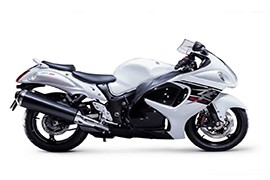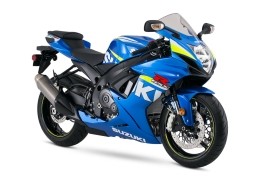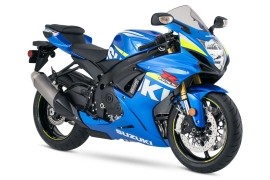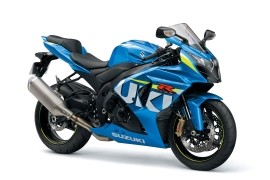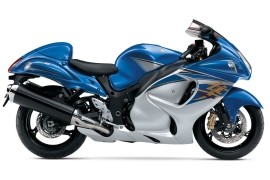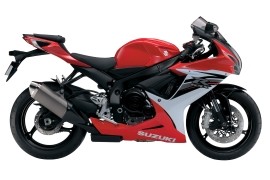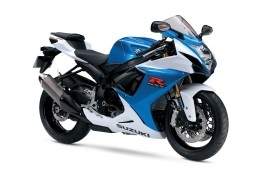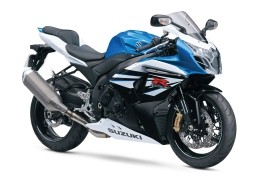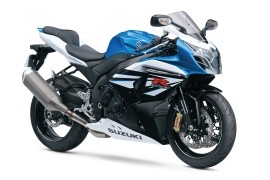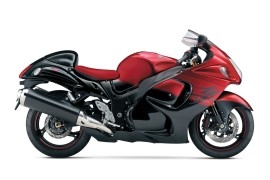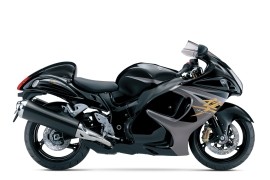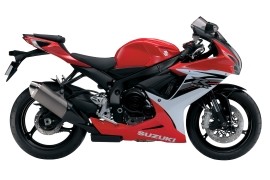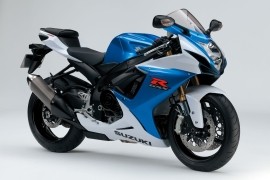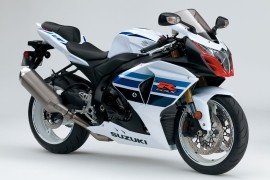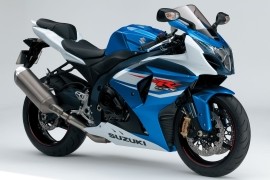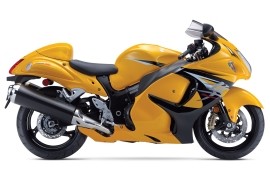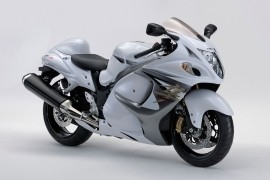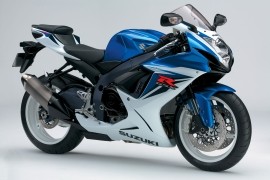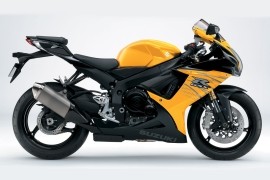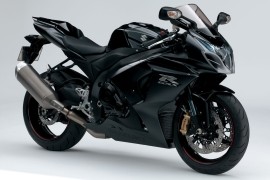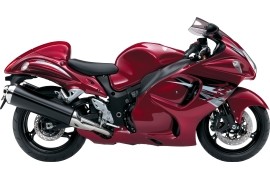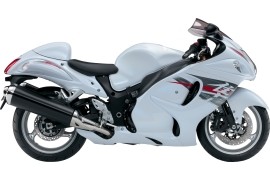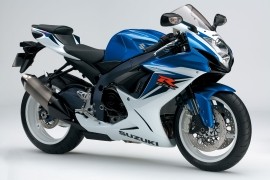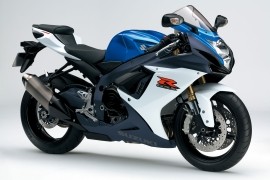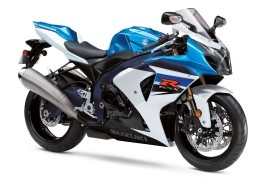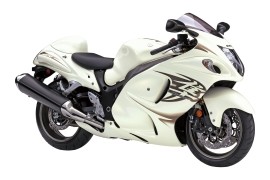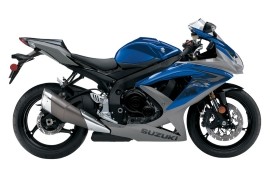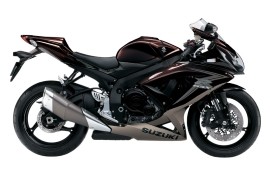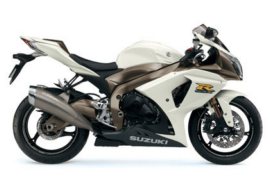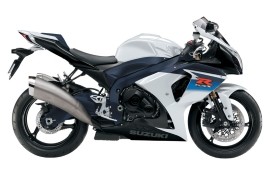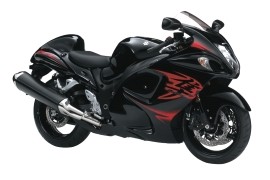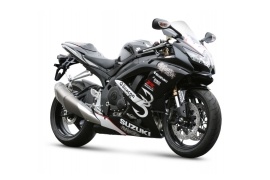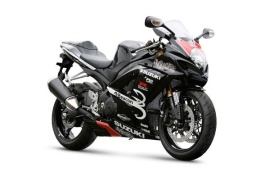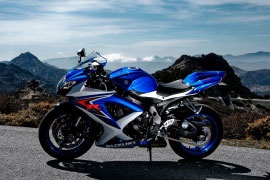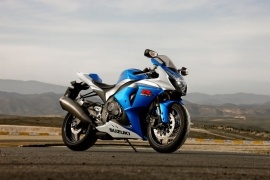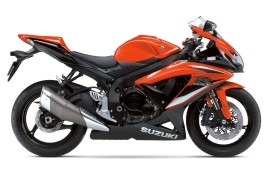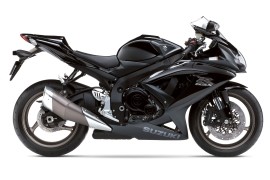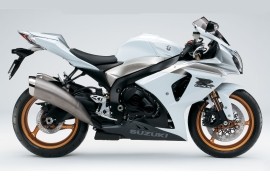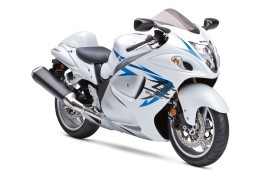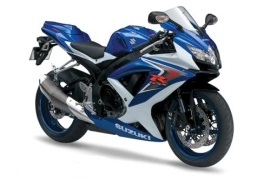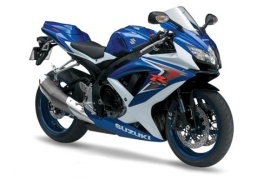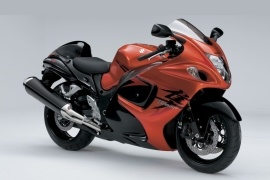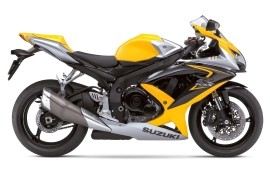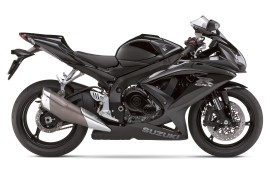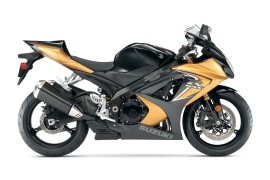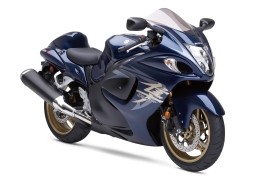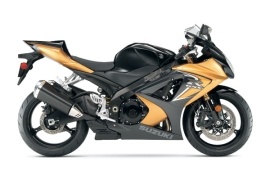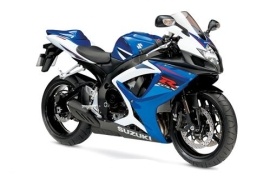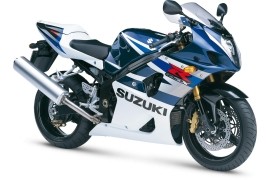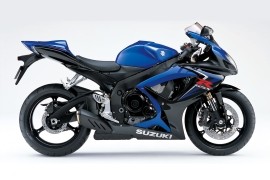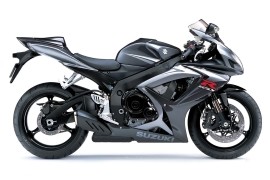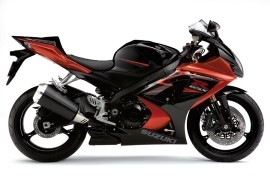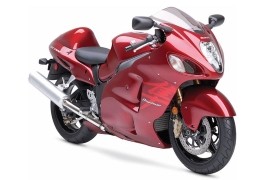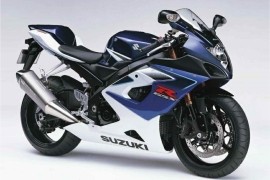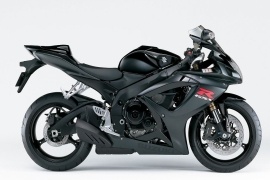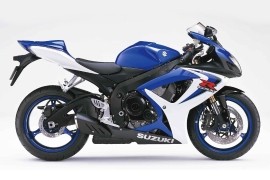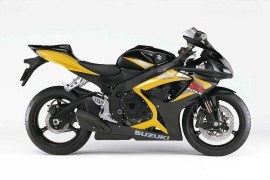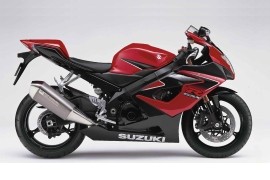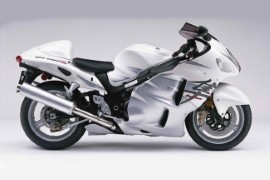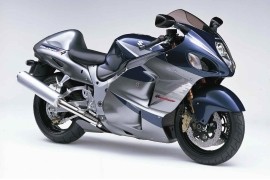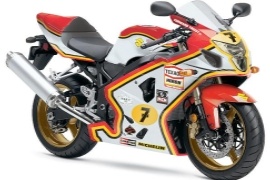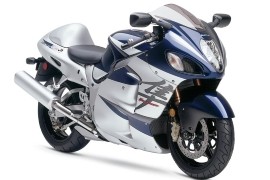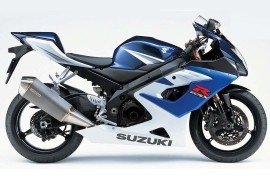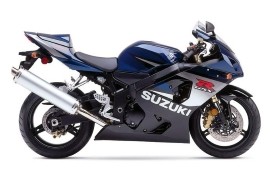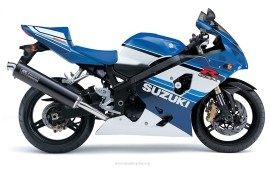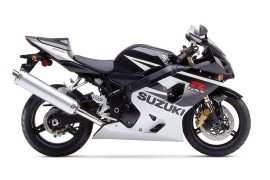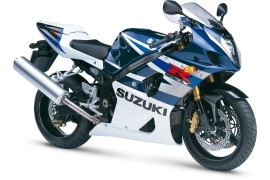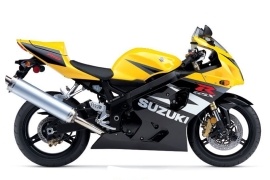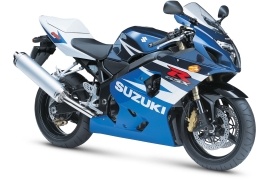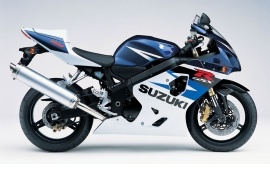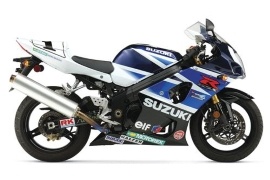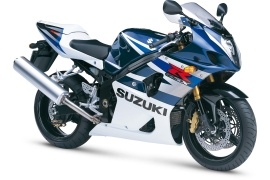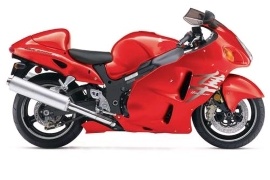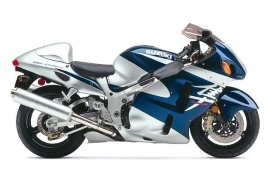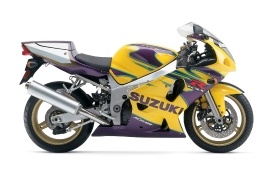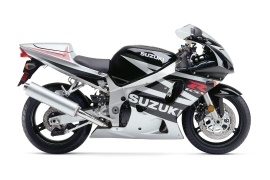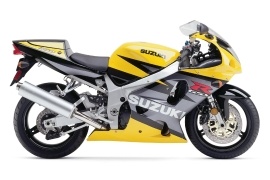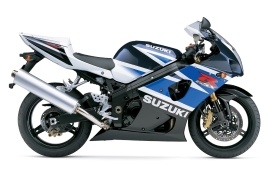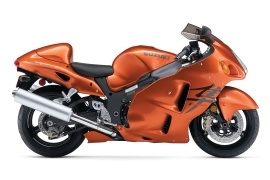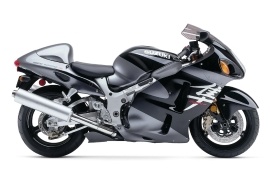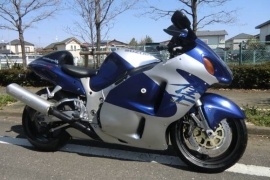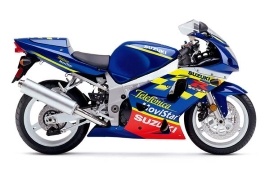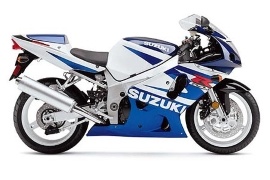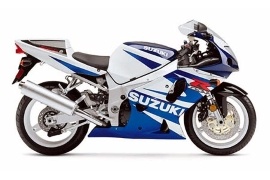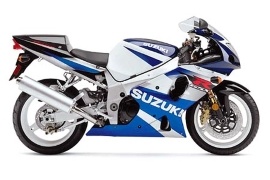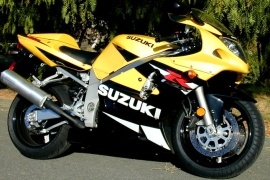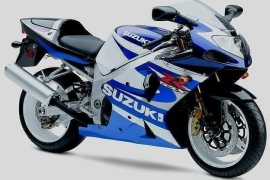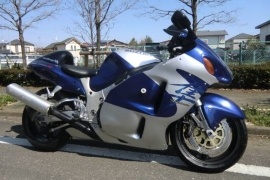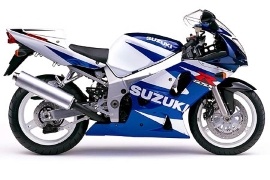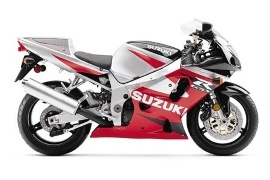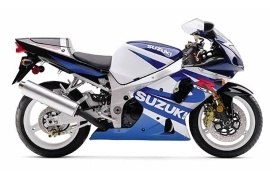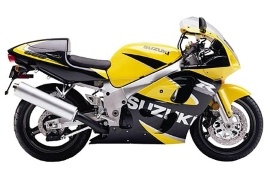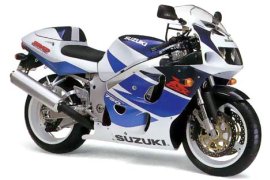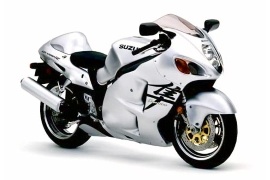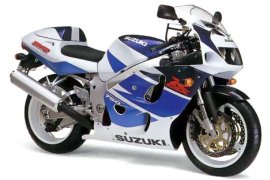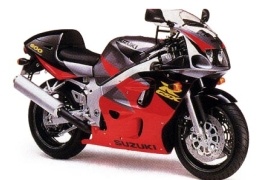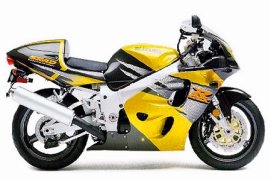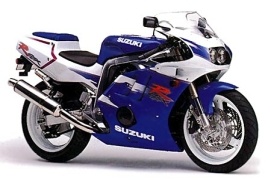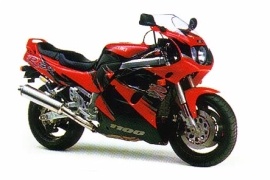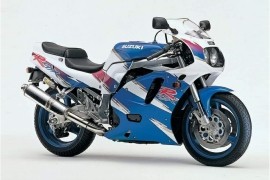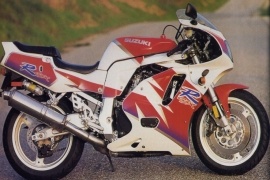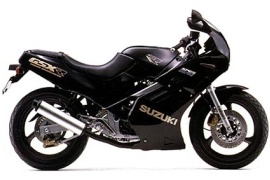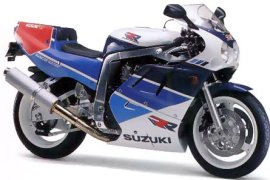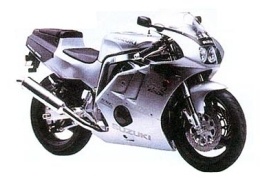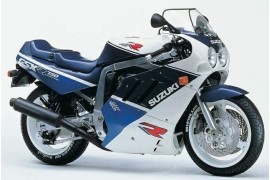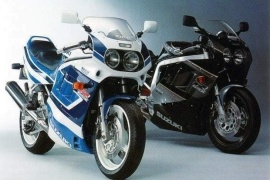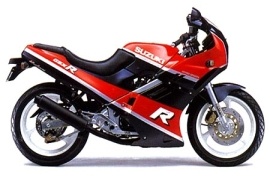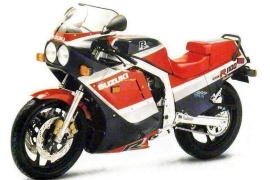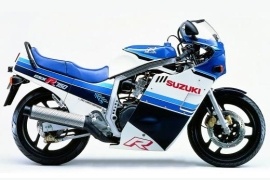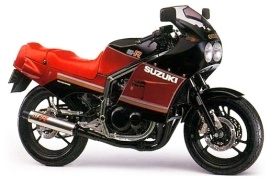SUZUKI GSX-R Models/Series Timeline, Specifications & Photos
First production year: 1984
In 1999, when the first Suzuki GSX 1300R was introduced, it immediately won the award of the fastest production motorcycle with a top speed of 303-312 kph (188-194 mph).
In 2017, Suzuki launched the GSX 1300R Hayabusa, a sports motorcycle in its second generation that featured lots of technical and visual improvements since its first release in 1999. The motorcycle design was carefully sculpted and perfectly merged the rider with the bike and had extensive hours of testing in a wind tunnel with a rider on top to find the perfect shape for high-speed riding.
Suzuki used a lightweight and rigid twin-spar aluminum frame for less weight with high torsional rigidity and a bridged aluminum swingarm with a cross-sectional shape for increased rigidity. At the front end of the frame, a 43 mm KYB inverted cartridge fork with a Diamond-Like Carbon (DLC) coating provided the front suspension with 120 mm of travel and fully adjustable spring preload, compression damping, and rebound damping.
In the power department, the 2017 Suzuki GSX 1300R Hayabusa had its heartbeat set by a 1,340cc four-stroke four-cylinder liquid-cooled engine with lightweight titanium valves, iridium spark plugs, and Suzuki Composite Electrochemical Material (SCEM) plated cylinders that improved heat transfer, durability, and seal. The 2017 bike developed a power output of 196 hp with a peak at 9,800 rpm and 154 Nm (114 lb-ft) of torque at 7,200 rpm and featured a six-speed manual transmission.
In addition to all tricks and tweaks, the bike featured a Suzuki Drive Mode Selector that allowed the driver to choose one of the three engine control maps to suit personal and various driving conditions.
The GSX-R600 was one of the most popular street-legal supersport bikes, and it only got better and better with each passing year. Because Suzuki was back to MotoGP in 2015, it was natural that one of the liveries evoked the premier class Racing Blue colors.
Some of the technologies from MotoGP made it to the GSX-R600 in one form or another, such as the high-tech slipper clutch, Brembo monoblock calipers, Showa BPF suspensions, driving modes, adjustable pegs, and more.
The 2015 Suzuki GSX-R600 featured MotoGP technology with lighter forged pistons and more aggressive valve lift curves that raised the throttle response and enhanced torque in the low-mid rpm range. Thanks to a close-ratio six-speed transmission, the bike benefitted with better starts, stronger accelerations, and faster exits out of the corners.
To match the extra power, the bike featured four-piston Brembo monoblock radial-mount calipers that worked together with two 310 mm discs on the front wheel and a two-piston caliper with a single 220 mm disc on the rear wheel.
It also featured a Suzuki Drive Mode Selector (SDMS) with two separate engine maps that gave instant control over the power delivery best suited for both track and road conditions. The three-way adjustable footpegs were meant to provide more comfort, control, and less fatigue.
With the 599cc four-stroke four-cylinder liquid-cooled engine installed at the base of an aluminum twin-spar extrusion frame, the bike developed an output power of 125 hp at 13,500 rpm and 68 Nm (50 lb-ft) of torque at 11,500 rpm. Combined with a six-speed transmission and a dry weight of 160 kg (352 lbs), the bike reached a top speed of 253 kph (157 mph)
In 2015, three decades after the first GSX-R introduction, Suzuki launched the 2015 model year GSX-R750, which carried on the racing heritage from day one. With an output power that almost tapped into the liter-class superbike territory, the model offered everything in a compact size, more like a 600cc Gixxer, and qualified as the worthiest successor of the great racers of yore.
The 2015 model, packed with Brembo Monoblock Radial Mount Calipers, provided better braking performance and was more rigid for better feedback. The suspension package featured Showa Big Piston Forks on the front for quicker reaction and improved damping force, more controlled compression under heavy braking conditions, and enhanced grip.
Two separate performance settings were available with the Suzuki Drive Mode Selector (SDMS), which offered instant control over the power, both on the road and track. For a comfortable position, the model featured three-way adjustable footpegs, an adjustable shift lever, and a short fuel tank.
In the power department, the 2015 Suzuki GSX-R750 featured a 749cc engine with forged pistons, titanium valves, an SDTV fuel injection system with eight-hole injectors, a four-into-one stainless steel exhaust system with a titanium muffler fitted with a SET valve for improved torque in the low-mid rpm range.
With the 749cc four-stroke four-cylinder liquid-cooled engine throttled to the maximum, it developed an output power of 148 hp at 12,800 rpm and 86 Nm (64 lb-ft) of torque at 11,200 rpm and pushed the bike to a top speed of 271 kph (168 mph).
Suzuki GSX-R1000 motorcycle was for more than a decade, the most successful name in the 1000cc production of motorcycles and earned the title of The Top Performer. In 2015 Suzuki released the GSX-R1000 model, a legendary motorcycle that featured amazing throttle response, power, and acceleration at mid-range engine speeds.
With the 2015 model, Suzuki commemorated the return to MotoGP racing with the newly released motorcycle dressed in a Racing Blue livery. The instrument cluster featured a tachometer defined by a silver ring and an LCD speedometer. The footpegs were 14 mm vertical and horizontally adjustable, while the rear brake pedal moved along with the whole assembly of the right footpeg, and the shift lever was also adjustable along with the left footpeg assembly.
The model featured ABS as a standard option, which enhanced the braking performance and kept the wheels from locking on hard braking or changes in road conditions. It also featured a fully adjustable suspension, a Suzuki Drive Mode Selector (SDMS), and a race-proved slipper clutch.
In the power department, the 2015 Suzuki GSX-R1000, powered by a 999cc four-stroke four-cylinder liquid-cooled engine, developed a power output of 182 hp at 12,000 rpm and 117 Nm (86 lb-ft) of torque at 10,000 rpm. Combined with a six-speed manual transmission and a wet weight of 203 kg (448 lbs), the bike measured a top speed of 299 kph (186 mph).
In 2015, Suzuki launched the GSX-1300R Hayabusa, a sports motorcycle that came a bit tweaked by the maker, even though was hard to make dramatic improvements to such a piece of machinery.
The new bike was a tad better than the previous versions, with the Brembo monoblock radial-mount front calipers that got bigger pistons for more stopping power and an increased feeling of control when braking at any speed. The standard ABS introduced yet another degree of safety and control and was the most welcome addition to this hyperbike.
In addition, the bike featured a Suzuki Drive Mode Selector that gave the rider a choice of three engine map settings that suited their personal performance style and various riding conditions. At the time of its release, the bike came with two styled color schemes, Metallic Thunder Grey with Glass Sparkle Black, and Pearl Bracing White with Metallic Mystic Silver.
The 2015 Suzuki GSX-1300R Hayabusa ABS took its thrust from a 1,340cc four-stroke four-cylinder liquid-cooled engine that developed a power output of 196 hp with a peak at 9,800 rpm and 154 Nm (114 lb-ft) of torque available at 7,200 rpm. The massive power produced by the engine was sent to the rear wheel through a six-speed manual transmission and pushed the bike to a top speed of 297 kph (184 mph).
In 2014, Suzuki launched the GSX-R600, a motorcycle that represented the new generation of street-going sport bikes, a nifty heritage of more than one million Gixxers manufactured, and an excellent testimony of motorcycle-making excellence. In the past years, Suzuki did not make dramatic changes to its bikes but compensated with step-by-step improvements and tweaks, which allowed the GSX-R600 to keep up with the competition and even dominate the racing series.
The bike featured a lightweight and compact twin-spar aluminum cradle frame made of five cast sections linked to a cast aluminum swingarm, on which was mounted the race-developed suspension, with a 41 mm Showa Big Piston Fork (BPF) on the front that delivered unmatched feedback and consistent performance and an adjustable Showa monoshock on the rear.
The bike came equipped with three-way adjustable footpegs, an adjustable shift lever, and a short fuel tank, which created a more comfortable position. The lightweight and compact instrument cluster featured an analog tachometer with an LCD that showed the speed, clock, coolant temperature, oil pressure, gear position indicator, and more.
In the power department, the 2014 Suzuki GSX-R600 came with lightweight, durable forged pistons, Suzuki Dual Throttle Valve System (SDTV), Suzuki Drive Mode Selector (SDMS), and a four-in-one stainless steel exhaust system.
The bike was taking its thrust from a 599cc four-stroke four-cylinder liquid-cooled engine, which developed an output power of 125 hp at 13,500 rpm and 68 Nm (50 lb-ft) of torque at 11,500 rpm. With a dry weight of 160 kg (352 lbs), the bike registered a top speed of 253 kph (157 mph).
When the first GSX-R750 started roaming the streets and spreading fear on the racetracks, Suzuki knew that it stumbled into a unique recipe for a legendary supersport bike.
Almost three decades after the Gixxer family was born, Suzuki launched the GSX-R750, which proudly showed that it has gone a long way and lived up to great expectations. The bike packed weight and dimensions like the 600cc Gixxer but backed by a solid amount of extra power and torque like any decent racing-focused machine delivered.
The 2014 Suzuki GSX-R750 featured a race-proven engine with high-revving performance thanks to its forged pistons, pentagonal ventilation holes, lightweight titanium valves controlled by a single valve spring to reduce mechanical losses, four-into-one exhaust system with a titanium muffler, and much more tweaks and tricks.
The 2014 Suzuki GSX-R750 bike had its heartbeat set by a 749cc four-stroke four-cylinder liquid-cooled engine with an output power of 148 hp at 12,800 rpm and 86 Nm (64 lb-ft) of torque with a peak at 11,200 rpm.
The bike featured three-way adjustable footpegs, an adjustable shift lever, and a shorter fuel tank for a more comfortable seating position. It also came equipped with a lightweight instrument cluster, incorporated with a lap timer/stopwatch and programable engine rpm indicators.
Saving the best for last, the engine power, combined with a six-speed manual transmission and a dry weight of 156 kg (344lbs), knocked the radar on the ground when it passed through with a top speed of 271 kph (168 mph).
After hitting the one million Gixxer milestone with the Commemorative Edition launched in 2013, Suzuki celebrated 50 years of motorcycle production in 2014, with the released of a Special Edition motorcycle manufactured in just only 100 units with a total of 50 numbered motorcycles made for the American market and another 50 sold worldwide.
The 2014 Suzuki GSX-R1000SE was a limited-edition machine that featured a special livery that harked back to the bright, lively color schemes of the first Gixxers, adorned with blue anodized elements and accents.
The eye-catching feature of the bike consisted of a blue chain, blue engine covers, blue fork legs and caps, blue ram air intakes, and the serial number that stated the bike's nature.
The SE model featured a twin-spar aluminum frame that housed a fully adjustable inverted telescopic fork on the front and a fully adjustable monoshock on the rear.
For stopping power, the bike packed two four-piston radial-mounted Brembo calipers that pressed on two 310 mm discs on the front and a single 220 mm disc with a hydraulic caliper on the rear.
The bike was taking its power from a 998cc four-stroke four-cylinder liquid-cooled engine with a power output of 182 hp at 12,000 rpm and 117 Nm (86 lb-ft) of torque at 10,000. Bolted to a six-speed manual transmission, the model reached a top speed of 299 kph (186 mph).
In 2014, Suzuki launched the GSX-R1000, a supersport motorcycle that offered a large amount of performance at every engine speed, smooth suspension performance, outstanding handling, and top-class braking power.
The GSX-R1000 was a bike developed for the racetrack but also released on the streets, and since 1985 when the first GSX-R motorcycle was born, Suzuki refined every model within each passing year to deliver more performance and agility.
The lightweight and compact twin-spar cradle frame, owned by the GSX-R model, was made of five cast sections linked to an arched swingarm made of three castings and a diecast subframe. Onto the frame, the lightweight, fully adjustable 43 mm Showa Big Piston Fork (BPF) on the front and the adjustable rear shock absorber provided the race-proven suspension.
In the power department, the bike featured lightweight and durable forged pistons, a trapezoidal efficient radiator and oil cooler designed to reduce drag force, and a four-two-one exhaust system equipped with Suzuki Exhaust Tuning (SET) which maximized torque and throttle response in the low-mid engine speeds.
The 998cc four-stroke four-cylinder liquid-cooled engine that powered the flagship model developed a power output of 182 hp at 12,000 rpm and 117 Nm (86 lb-ft) of torque with a peak at 10,000 rpm. Due to a six-speed manual transmission and a wet weight of 203 kg (448 lbs), the 2014 Suzuki GSX-R1000 motorcycle registered a top speed of 299 kph (186 mph).
With the release of the 2014 GSX-1300R ABS Hayabusa 50th Anniversary Edition, Suzuki celebrated half a century of bike manufacturing at the house of Hamamatsu. A success story that had covered anything from small beginner bikes to dirt machines, sport and all-rounder motorcycles for everyday use, and highly engineered beasts that dominated the racing tracks all over the world.
Hayabusa, probably the flagship Suzuki bike, received a two-tone Red and Black livery with a cool gradient transition sector between the two colors, a thing which is quite uncommon in the sport bike world.
On the tech side, the GSX-1300R Hayabusa ABS 50th Anniversary Edition was identical to the base version and included a three-mode drive selector, hybrid, slightly retro dashboard, Brembo monoblock calipers, and much more.
The bike’s engine received lightweight aluminum alloy pistons for maximum performance in all conditions, lightweight titanium valves, and iridium spark plugs for high combustion efficiency. With a 1,340cc displacement, the four-stroke four-cylinder liquid-cooled engine delivered an output power of 196 hp at 9,800 rpm and 154 Nm (114 lb-ft) of torque available at 7,200 rpm.
On the front, the bike featured a cast aluminum wheel with two 310 mm discs and four-piston Brembo calipers, and the rear cast aluminum wheel packed a single 260 mm disc with a one-piston caliper that acted as braking power.
In 2014, Suzuki released the GSX1300R Hayabusa ABS, a Japanese spec version of the globally known world-leading sports motorcycle, which was specially homologated for the Japanese market but with power specs like the European models.
As a standard feature for the Japanese model, the maker installed the onboard Electronic Toll Collection device, which made the 2014 Suzuki GSX1300R Hayabusa ABS the first motorcycle in Japan with that feature. It also retained the hybrid dashboard combined with analog gauges for the speedometer, tachometer, fuel gauge, water temperature, and digital indicators.
The model also featured the Suzuki Drive Mode Selector (SDMS) for perfect compliance with various riding conditions and rider preferences like the European models. In addition, the manufacturer fitted the bike with powerful radial monoblock brake calipers on the front wheel, and for more safety, it also featured Anti-Lock Brake System (ABS).
The 1,339cc four-stroke four-cylinder liquid-cooled engine featured by the Japanese version developed an output power of 197 hp at 9,500 rpm and 155 Nm (114 lb-ft) of torque available at 7,200 rpm. The engine power, combined with the spinning guts of a six-speed manual transmission and a wet weight of 266 kg (586 lbs), the bike reached a top speed of 297 kph (184 mph).
The 2014 GSX1300R Hayabusa was for sale in 2022 starting from $10,000.
In 2013, Suzuki released the GSX-R600, a bike with multiple racing accolades to its name, which remained one of the best-loved Supersport-class street machines ever made. The 2013 model carried on the successful recipe with refined performance and technology that delivered an even more rewarding riding experience on both track and urban tarmac.
With added Showa Big Piston front fork, a precise rear monoshock, a new shorter aluminum twin-spar extrusion frame, radial monoblock four-piston Brembo calipers on the front, and multiple other race-derived parts, the bike felt surprisingly bold each time. For a more comfortable position, the bike packed three-way adjustable footpegs, an adjustable shift lever, and a short fuel tank.
The engine featured lightweight and durable forged pistons, a Suzuki Dual Throttle Valve (SDTV) fuel injection system that used eight-hole injectors for more performance, and a Suzuki Drive Mode Selector (SDMS) system, which offered at a push-of-a-button two-race-developed engine control maps to suit road conditions and personal performance preference.
The 2013 Suzuki GSX-R600, was taking its thrust from a 599cc four-stroke four-cylinder liquid-cooled engine that developed a power output of 125 hp at 13,500 rpm and 68 Nm (50 lb-ft) of torque at 11,500 rpm. The engine power, combined with a six-speed manual transmission and a dry weight of 160 kg (352 lbs), pushed the bike to a top speed of 253 kph (157 mph).
Back in 1985, Suzuki brought into the world the GSX-R750, which became the foundation for the present sportbikes. With its lightweight frame and amazing power, the GSX-R750 won the Le Man’s 24-hour World Endurance Championship at the time of its debut.
The modern models have only gotten better and better, with Suzuki constantly working to increase power and improve handling, turning them into modern, state-of-the-art machines. If anything, the GSX-R750 was the sweet spot between the lightweight 600cc motorcycles and the uncompromised performance of the liter-class bikes.
In 2013, Suzuki launched the GSX-R750 motorcycle, built around a lightweight and compact twin-spar aluminum cradle frame that featured a cast-aluminum swingarm. It also featured an electronically controlled steering damper that provided lighter steering at lower speeds and more damping force at racetrack and highway speeds.
The 2013 Suzuki GSX-R750 took its thrust from the proven 749cc four-stroke four-cylinder liquid-cooled engine that offered a power output of 148 hp at 12.800 and 86 Nm (64 lb-ft) of torque at 11,200 rpm. When combined with a six-speed manual transmission and a dry weight of 156 kg (344 lbs), the result was a top speed of 271 kph (168 mph).
The bike featured a fully adjustable race-developed suspension with a Brembo braking system followed by cast aluminum wheels for enhanced performance.
The GSX-R1000 Commemorative Edition was a supersport motorcycle manufactured by Suzuki in 2013 as a special edition that marked the production of one million GSX-R motorcycles. It all started in 1985 when the first GSX-R750 was born and soon proved to be the flagship model of the range of motorcycle racing.
So, the GSX-R1000 Commemorative Edition motorcycle manufactured by Suzuki in 1985 units was to mark the first year when the flagship model was born. The special edition of the GSX-R1000 featured class-mastering performance and cutting-edge technology dressed in a new color scheme that reflected its race heritage.
Some of the key features that came with the bike were a serial plate attached on the upper front fork bracket with red-anodized caps and gold-colored outer tube, a red rear suspension spring, black Brembo calipers with red lettering, a pinstripe design on the wheels, and a key fob with the letter "R" printed on it.
Jumping into the power department, the commemorative edition model had at its core a 998cc four-stroke four-cylinder liquid-cooled engine that delivered a power output of 182 hp with a peak at 12,000 rpm and 117 Nm (86 lb-ft) of torque available at 10,000 rpm. All the power produced by the engine was sent to the rear wheel through a six-speed manual transmission, and with an overall wet weight of 203 kg (448 lbs), the bike flew to a top speed of 299 kph (186 mph).
In 2013, Suzuki released the GSX-R1000, a supersport motorcycle with great throttle response, power, and acceleration at mid-range engine speeds that also delivered good fuel economy. From idle to the red line, the model offered outstanding engine performance, smooth suspension performance, responsive handling, and superior braking performance.
The bike was built around a lightweight and compact twin-spar cradle frame that hosted a compact engine, which allowed a longer swingarm to be installed for a shorter wheelbase and better on-track performance.
The 2012 model featured a four-two-one exhaust system fitted with the Suzuki Exhaust Tuning (SET) valve that maximized torque and improved throttle response in the low-mid rpm range. With the Suzuki Drive Mode Selector (SDMS) system switch mounted on the left handlebar, at a press of a button, the rider had to choose from three fuel injection and ignition system maps, which adjusted the performance to fit the personal preference.
The 999cc four-stroke four-cylinder liquid-cooled engine installed in the GSX-R1000 developed an output power of 182 hp at 12,000 rpm and 117 Nm (86 lb-ft) of torque with a peak at 10,000 rpm. When the power generated by the engine, combined with the spinning guts of a six-speed manual transmission and a wet weight of 203 kg (448 lbs), resulted in a top speed of 299 kph (186 mph).
If you see a yellow Hayabusa rolling down the street and it looks like one of the new models, you're probably looking at the 2013 MY GSX-1300R Hayabusa Limited Edition. This limited run bike arrives in a a Marble Daytona Yellow/ Glass Sparkle Black livery you just can't get from anywhere else, and this is basically what sets it apart from the base model.
On the tech side, the bike is identical to the base version, and this means it has received the new radial Brembo brakes with larger pistons with ABS as standard, tweaked engine and revised transmission with a Suzuki Clutch Assist System (SCAS) back-torque-limiting clutch.
In 2013, Suzuki launched the GSX-1300R Hayabusa ABS, and as its name says, the bike was delivered with standard ABS and was Suzuki's first bike in the sport range that offered the safety feature technology. Radial Brembo monoblock front brake calipers came as standard with larger pistons for more braking performance.
The new Hayabusa offered three selectable engine maps that allowed the rider to choose one mode that suited its personal performance preference or on-road conditions and the Suzuki Clutch Assist System (SCAS) back-torque-limiting clutch for smoother operation and safer downshifting.
Multiple other refinements made the engine more reliable, while extensive wind tunnel testing also improved aerodynamics.
The 2013 Suzuki GSX-1300R Hayabusa ABS was put together around a twin-spar aluminum frame with a 1,340cc engine at its core, fully adjustable suspension at each end, Brembo monoblock brakes, and an aerodynamic bodywork that was famed for cutting through the air with massive agility and performance.
The heart of the Hayabusa was a four-stroke four-cylinder liquid-cooled engine that delivered a power output of 196 hp at 9,800 rpm and 154 Nm (114 lb-ft) of torque at 7,200 rpm bolted to a six-speed manual transmission that helped the bike reach a top speed of 297 kph (184 mph).
With a dry weight of 220 kg (485 lbs), the model scored three seconds from a standstill to 100 kph (60 mph).
In 2012, Suzuki released the GSX-R600, a supersport motorcycle that shared the technological improvements that its bigger sisters benefited from the MotoGP and Endurance racing series. The bike got lighter, and thus improved the power-to-weight ratio, dominated the class, and provided an even more explosive performance.
Radial monoblock four-piston Brembo calipers were part of the standard equipment with two 310 mm discs on the front and a 220 mm disc with a Nissin two-piston caliper on the rear. The frame was redesigned to fit the Showa Big Piston Fork (BPF) front suspension and the new rear monoshock.
The bike featured a Suzuki Drive Mode Selector (SDMS) system that offered two race-developed engine maps at a push of a button for personal preference and to suit road conditions.
The engine featured the Suzuki Dual Throttle (SDTV) fuel injection system, which used eight-hole injectors that improved combustion efficiency and delivered smooth power. The 2012 Suzuki GSX-R600 model, powered by a 599cc four-stroke four-cylinder liquid-cooled engine with a power output of 125 hp at 13,500 rpm and 68 Nm (50 lb-ft) of torque with a peak at 11,500 rpm, combined with a six-speed manual transmission and a dry weight of 160 kg (352 lbs), launched the bike to a top speed of 253 kph (157 mph).
In 2012, Suzuki released the GSX-R750, a supersport motorcycle with a massive 8 kg (18 lbs) weight reduction, which probably was the biggest improvement of the model.
A bunch of bits and pieces were redesigned using the latest developments of the MotoGP and Endurance World Championship programs, which allowed Suzuki to maintain or increase the performance while making it lighter and more compact, with an improved feel.
The chassis consisted of a lightweight and compact aluminum twin-spar cradle frame made of five cast sections with a cast-aluminum swingarm complemented by the 41 mm fully adjustable Showa inverted telescopic fork on the front and the fully adjustable Showa aluminum shock on the rear.
For brakes, the model featured two 320 mm discs with radial-mounted four-piston Brembo calipers on the front and a single 220 mm disc with a one-piston Nissin caliper on the rear.
In the power department, the 2012 Suzuki GSX-R750, powered by a 749cc four-stroke four-cylinder liquid-cooled engine with forged pistons, pentagonal ventilation holes for better performance, and lightweight titanium valves, developed an output power of 148 hp at 12,800 rpm and 86 Nm (64 lb-ft) of torque at 11,200 rpm.
The power output, combined with a dry weight of 156 kg (344 lbs) and a six-speed transmission, resulted in a top speed of 271 kph (168 mph).
The hot gases produced by the engine were escaping through a four-in-one stainless steel exhaust system with a titanium muffler and a Suzuki Exhaust Tuning (SET) valve that maximized torque and improved throttle response in the low-mid rpm range.
In 2012, Suzuki launched the GSX-R1000, a superbike motorcycle that got a lot better with elements gathered from Suzuki’s global race teams and on-track success. The 2012 model featured a redesigned engine, chassis, suspension, and bodywork to become a more dominant superbike than ever.
The upgraded model featured new materials for a lighter, better-revving engine with increased compression. At the same time, the GSX-R1000 received radial Brembo brakes with two 310 mm discs and two Brembo monoblocks with four-piston calipers on the front wheel and a 220 mm disc on the rear wheel.
The model featured enhanced maneuverability thanks to the weight-reduced front tire and axle, which offered superior weight advantages.
Also, the bike received a new ECM for top-drawer engine management, three engine mappings, clear lens turn signals, and a host of other minute tweaks imported from the MotoGP and Endurance World Championship.
In the power department, the 2012 Suzuki GSX-R1000 was taking its thrust from the 999cc four-stroke four-cylinder liquid-cooled engine with a power output of 182 hp with a peak at 12,000 rpm and 117 Nm (86 lb-ft) of torque available at 10,000 rpm.
The massive power crafted by the engine, combined with a six-speed manual transmission and a wet weight of 203 kg (448 lbs), knocked down the speed camera when it passed it with a top speed of 299 kph (186 mph).
Suzuki was hanging on to the very good tradition of delivering Special and Limited-Edition machines, and for 2012, the house of Hamamatsu prepared a small run of GSX-1300R Hayabusa Limited Edition bikes. Those machines were easily recognizable as they came in a new Candy Sonoma Red livery which was a real head-turner.
On the tech side, the GSX-1300R Hayabusa Limited Edition shared all the upgrades with the base model, which included the revised rear subframe, fuel tank position, redesigned dashboard, new four-two-one-two exhaust system, new-design wheels, and a three-way driving mode selector.
In addition, the bike featured Suzuki Dual Throttle Valve (SDTV) fuel injection system with two fuel injectors per cylinder that improved power delivery, better fuel economy, and lower emissions, and Idle Speed Control (ISC) system that enhanced cold starting while maintaining a stable idle in various conditions.
Key features of the bike included the instrument cluster redesigned with four analog meters for the speedometer, tachometer, fuel gauge, and water temperature indicator, while the engine packed lightweight titanium intake and exhaust valves, lightweight aluminum pistons, and a large volume four-two-one-two exhaust system with a high-capacity catalyzer.
The 1,340cc four-stroke four-cylinder liquid-cooled engine installed on the Limited Edition Hayabusa featured the same specs as the base model, such as a power output of 196 hp at 9,800 rpm and 154 Nm (114 lb-ft) of torque at 7,200 rpm.
In 2012, Suzuki launched the GSX-1300R Hayabusa, a sports motorcycle that came with several improvements, such as a new Suzuki Drive Mode Selector (SDMS), with three different engine maps available for the rider, that changed the engine character according to various riding situations and for personal performance preference.
It also included a redesigned four-two-one-two exhausts system with large-volume cans relocated for better banking, enhanced power, and reduced noise. Other redesigned features were the dashboard, new three-spoke cast aluminum wheels shod with radial tires, a relocated fuel tank, and vertically stacked headlights.
The bike featured a lightweight and rigid twin-spar aluminum frame that minimized weight and retained the high torsional strength with a cross-sectional shaped bridged aluminum swingarm that offered increased rigidity, rear tire grip, and enhanced power output.
The frame was dressed in an aerodynamic fairing that provided enhanced wind protection for both normal and tucked-in positions.
Taking a step into the figures department, the 2012 Suzuki GSX-1300R Hayabusa packed at its core a 1340cc four-stroke four-cylinder liquid-cooled engine that delivered an output power of 196 hp at 9,800 rpm and 154 Nm with a peak at 7,200 rpm. Combined, the engine power with a wet weight of 266 kg (586 lbs) and a six-speed manual transmission resulted in a top speed of 297 kph (184 mph).
In 2011, Suzuki released the GSX-R600, atop-class 600cc performance motorcycle that featured technologies proven on the world’s racetracks.
Compared to the previous model, Suzuki paid a great deal of attention to weight reduction, applied to every single part of the bike such as exterior plastic parts, muffler, rear suspension, frame, front forks, swingarm, and front brake calipers, which resulted in a nine kg (20 lbs) weight loss.
Combined with the weight reduction, the decision taken by Suzuki to shorten the wheelbase by 15 mm ensured a class-leading performance and a fuel economy improvement, and also achieved an optimized riding balance with the lightweight and compact built-in turn signals and taillights.
In the power department, every moving part of the engine was redesigned, which reduced the overall weight of the engine by two kg (four lbs). Also, the Suzuki engineers took care of the mechanical losses and improved performance at low and medium speeds.
The 599cc four-stroke four-cylinder liquid-cooled engine featured by the 2011 Suzuki GSX-R600 developed a power output of 126 hp at 13,500 rpm and 67 Nm (49 lb-ft) of torque at 11,500 rpm. The power produced by the engine, combined with a six-speed manual transmission and a dry weight of 187 kg (412 lbs), pushed the bike to a top speed of 253 kph (157 mph).
In 2011, Suzuki released the GSX-R750, a motorcycle that combined the new design of a 750cc DOHC engine with the chassis of the GSX-R600 model developed at the same time. The Suzuki manufacturer focused on weight reduction targeting the exterior plastic parts, muffler, frame, front forks, rear suspension, swingarm, and brake calipers.
Along with the weight reduction, which reached 190 kg (419 lbs), eight kg lighter than the 2010 GSX-R750 model, came better cornering performance and increased handling.
The vertically stacked headlights made the bike recognizable as a member of the GSX-R range, and a good riding balance was achieved with the compact and lightweight integrated turn signals and taillights.
At the core of the motorcycle, the 749cc DOHC liquid-cooled engine, two kg lighter than its predecessors, and with mechanical losses reduced, the performance was improved at low and medium speeds with an output power of 150 hp at 13,200 rpm and 86 Nm (63 lb-ft) of torque with a peak at 11,200 rpm.
Onto the aluminum twin-spar frame, the 2011 Suzuki GSX-R750 featured an inverted telescopic fully adjustable fork on the front wheel and a fully adjustable spring preload on the rear.
In the braking department, the stopping power was provided by two 310 mm discs with four-piston calipers on the front and a single disc on the rear.
In 2011, Suzuki launched the GSX-R1000, a supersport motorcycle developed on racetracks that defined dominance and won seven straight AMA Superbike Championships in a row. There was no denying that the GSX-R1000, with its class-leading engine, chassis, and suspension technology, qualified as an undisputed superbike of the era at the time.
The 2011 model featured a compact twin-spar cradle frame paired with a die-cast one-piece rear subframe and an arched swingarm to make space for the twin titanium mufflers. The fairings and bodywork installed on the model were designed to reduce turbulence and drag resistance. It featured a carefully shaped seat for the comfort of the rider and three-way 14 mm vertical and horizontal adjustable footpegs.
In the power department, the model packed an engine that delivered an enhanced throttle response anywhere in the rpm range with great potential for racetrack performance with its high-quality titanium valves and forged pistons.
The 999cc four-stroke four-cylinder liquid-cooled engine that powered the 2011 model, with a power output of 182 hp at 12,000 rpm and 117 Nm (86 lb-ft) of torque with a peak at 10,000 rpm, equipped with a six-speed manual transmission, combined with a wet weight of 205 kg (452 lbs), pushed the bike to a top speed of 299 kph (186 mph).
In 2011, Suzuki released the GSX-1300R Hayabusa model, which came with two new liveries such as the Pearl Mirage White with Gold trim and Pearl Nebular Black with Red trim, and introduced even more elegance to the bikes that, over time became one of the iconic super sport-touring machines. No major updates were included in the 2011 model year, which proved that the GSX-1300R Hayabusa was made after a great recipe.
With performance credentials that went through the roof, the Hayabusa suit best the riders that settled for nothing less than the best. The bike packed a combination of massive power, crisp handling, and top-notch aerodynamics, which made it the ultimate sports bike in a class of its own.
The lightweight and rigid twin-spar aluminum frame was designed for minimized weight with the high torsional strength retained and packed a fully adjustable inverted fork on the front with Diamond-Like Coating (DLC) inner tubes that provided outstanding suspension performance over a variety of riding conditions and on the rear, it featured a link-type fully adjustable suspension.
The 1,340cc four-stroke four-cylinder liquid-cooled engine featured lightweight aluminum pistons with Suzuki Composite Electrochemical Material (SCEM) plating for improved heat transfer and more durability, lightweight titanium valves, and iridium spark plugs for high combustion efficiency. The 2011 Suzuki GSX-1300R Hayabusa delivered a power output of 196 hp at 9,800 rpm and 154 Nm (114 lb-ft) of torque with a peak at 7,200 rpm. The engine power was sent to the rear wheel through a six-speed manual transmission that pushed the bike to a top speed of 297 kph (184 mph).
The 2010 MY GSX-R600 retains the amazing nerve of this middleweight racer which was tamed a bit for city use. Multiple race-focused features have been kept in place, such as the radial brakes, advanced electronics package, premium suspensions and the chassis-engine combination which proved to be highly-favored one among sport bike enthusiasts.
However, no major technical improvements over previous versions can be recorded for this model, save for some aesthetic upgrades and minor tweaks.
The 2010 MY GSX-R750 maintains the successful recipe of its predecessors, putting on the street a bike designed for racing, but with amenities to make it legal and rideable in more casual scenarios. Open-class racetrack performance is delivered in a middleweight package which is usable for daily commuting as well. Still, riders get a fully-evil bike, equipped with fully-adjustable premium suspensions, on-the-fly adjustable engine mapping, radial mount calipers and many other features and technologies derived from the racing program.
In 2010, along with the GSX-R1000 model, Suzuki released a special edition of the GSX-R model to celebrate the 25th anniversary of the liter-class Gixxer, born in 1985. The GSX-R1000 25th anniversary came with a new look and featured significant changes such as a completely redesigned engine, chassis, suspension, brake, and bodywork developments like the 2009 model.
The special edition GSX-R1000 came dressed in a new livery with Metallic Mat Titanium Silver and Pearl Mirage White along with the R logo, which came in Yellow instead of Red. The 25th Anniversary inscription found its way on the muffler and featured stripes on both front and rear cast aluminum wheels.
The 25th-anniversary motorcycle came in only 1,000 copies, and every bike had a serial number plate on the yoke.
Jumping into the power department, the model had at its core a 998cc four-stroke four-cylinder liquid-cooled engine that developed an output power of 182 hp at 12,000 rpm and 117 Nm (86 lb-ft) of torque with a peak at 10,000 rpm. Combined with a six-speed transmission and a wet weight of 205 kg (452 lbs), the bike flew to a top speed of 299 kph (186 mph).
The bike featured fully adjustable race-developed suspension while the braking power was handled by two 310 mm discs with four-piston calipers on the front wheel and a 220 mm disc with a hydraulic caliper on the rear wheel.
In 2010, Suzuki launched the GSX-R1000, a supersport motorcycle that featured significant changes such as a completely redesigned engine and chassis, and major suspension, brake, and bodywork developments.
The chassis consisted of a compact twin-spar frame welded together with five aluminum alloy sections, such as the steering head, two main-spar/swingarm pivot plate sections, and two cross braces above and below the swingarm. For the twin titanium mufflers to be mounted on each side of the motorcycle, the swingarm was arched and manufactured with just three castings.
The bike also featured adjustable footpegs in a 14 mm horizontal and vertical range, an instrument cluster centered around an analog tachometer with an adjacent digital LCD speedometer, and a LED taillight and brake light integrated into the rear tail section.
The 999cc engine was lighter and shorter and featured Suzuki Dual Throttle Valve (SDTV) fuel injection system and delivered improved performance and throttle response while emissions were reduced.
The 2010 Suzuki GSX-R1000, powered by a 999cc four-stroke four-cylinder liquid-cooled engine with a power output of 182 hp at 12,000 rpm and 117 Nm (86 lb-ft) of torque at 10,000 rpm, combined with a six-speed transmission and a wet weight of 205 Kg (452 lbs), launched the bike to a top speed of 299 kph (189 mph).
In addition to all features, it was also equipped with Suzuki Drive Mode Selector (SDMS), which allowed the rider to choose between three engine maps to suit the personal performance style.
The 2010 season saw a Suzuki GSX-1300R Hayabusa, which carried on the upgrades introduced back in 2008. The highly aerodynamic bodywork was the unmistakable trademark of the bike, with its rounded, voluptuous shapes and aggressive sporty stance.
The thrust remained at new standards introduced by the recent power plant upgrade, which offered the most rewarding experience to skilled motorcyclists that knew what real power means.
The first GSX-1300R Hayabusa model, was listed by the Guinness Book of Records as the world’s fastest production bike ever made, with more than 303 kph (188 mph) on the clock, and because the Japanese manufacturers had to limit their bikes at 299 kph (186 mph) due to the new regulations at the time, it made future comparison impossible.
The 2010 Suzuki GSX-1300R Hayabusa had its heartbeat set by a 1,340cc four-stroke four-cylinder liquid-cooled engine that featured Suzuki Fuel Injection, delivered a power output of 196 hp at 9,800 rpm and 154 Nm (114 lb-ft) of torque at 7,200 rpm.
The bike registered some impressive figures such as 0 to 100 kph (0 to 60 mph) in just three seconds, 0 to 200 kph (0 to 124 mph) in just 7.3 seconds, and a top speed of 297 kph (184 mph). For stopping power, a couple of four-piston calipers pressed on two 310 mm discs on the front cast aluminum wheel, and a one-piston caliper squeezed a single 260 mm disc mounted on the rear wheel.
Bruce Anstey produced a stunning result winning the Supersport race on his GSX-R600 with a 34 second lead and setting a new lap-record in the process.To celebrate this sensational achievement, we have produced a special edition model in the team livery with celebratory graphics.In addition to the stunning livery and graphics you have all the standard benefits of the GSX-R600, a product of Suzuki's legendary integrated design approach. A machine designed and refined by a team of talented engineers to produce a revised, compact combination of chassis and engine, fitted with advanced electronics, sporting suspension and brakes to not only accelerate harder but also handle even better.
Cameron Donald finished first in the prestigious Superbike race and then went on to claim Suzuki's seventh consecutive Superstock win on-board his production-based GSX-R1000. To celebrate this sensational achievement, we have produced a special edition model in the team livery with celebratory graphics. This special edition model boasts all the benefits of the standard model with three engine power settings available at the flick of a switch for any road conditions, twin pipes offering greater balance and lower centre of gravity, whilst adjustable pegs create a better riding position. All this combined with the outstanding engine and chassis produces race winning performance, as proven by Cameron.
The GSX-R600 is a sport bike from Suzuki's GSX-R series of motorcycles. It was introduced in 1985 and can be considered to be the first of the modern racer-replicas with many race-derived technologies and the looks of a Suzuki Endurance racer at an affordable price.
The GSX-R750 is a sport bike from Suzuki's GSX-R series of motorcycles. It was introduced in 1985 and can be considered to be the first of the modern racer-replicas with many race-derived technologies and the looks of a Suzuki Endurance racer at an affordable price.
The GSX-R1000 is a super bike from Suzuki's GSX-R series of motorcycles. It was introduced in 2001 to replace the GSX-R1100 and is powered by a liquid-cooled 999 cc (61.0 cu in) inline four-cylinder 4-stroke engine.
In 2009, Suzuki launched the GSX-R600, an entry-point sportbike in the 2009 Suzuki line-up, which retained many features that gave it an extra edge on the racetrack and also used as a daily city slicer.
The GSX-R600 was often referred to as a benchmark machine for the class and was always in a constant battle for the top places. The new model didn't come with any significant differences from the previous models but instead offered consistent performance.
The bike featured an aggressive new bodywork design, a bold headlight design, and an angular tail section, mounted on an aluminum alloy frame made of five cast sections and designed for an ideal balance of rigidity for improved handling and weight reduction. For more rigidity and improved acceleration, the bike featured cast aluminum wheels in an angled five-spoke design.
For a more comfortable ride, the model featured die-cast three-way adjustable footpegs on 14 mm vertical and horizontal range. Also, the instrument cluster featured a compact and lightweight design with a step motor-controlled analog tachometer, LCD speedometer, clock, and a gear position indicator.
The 2009 Suzuki GSX-R600, had its heartbeat set by a 599cc four-stroke four-cylinder liquid-cooled engine that developed an output power of 125 hp at 13,500 rpm and 68 Nm (50 lb-ft) of torque at 11,500 rpm. With a dry weight of 163 kg (359 lbs), the bike reached a top speed of 253 kph (157 mph).
The GSX that started all the madness became better with each passing year, as Hamamatsu was constantly finding a way to tweak the machine for more performance even when no huge changes were implemented.
This allowed the stock version of the 2009 GSX-R750 to replicate a lot of the race bike's character, especially as radial brakes, adjustable high-performance suspensions, and on-the-fly engine mapping options that were also delivered as part of the package.
The 2009 GSX-R750 model featured a sharp and aggressive design implemented by a new headlight, an angular rear section, and a compact overall layout. For improved rigidity and acceleration, the lightweight cast aluminum wheels featured by the bike were manufactured in an angled spoke design.
The engine featured Suzuki Dual Throttle Valve (SDTV) system with two eight-hole injectors on each cylinder, (SDMS) that allowed the rider to choose from three engine modes depending on the riding conditions, Suzuki Idle Speed Control (ISC) that improved the cold start and reduced emissions, and a Suzuki Advanced Exhaust System (SAES) with a large muffler.
The power figures of the 2009 Suzuki GSX-R750 were produced by the 749cc four-stroke four-cylinder liquid-cooled engine with a power output of 148 hp at 12,800 rpm and 86 Nm (64 lb-ft) of torque at 11,200 rpm. Combined with a dry weight of 163 kg (359 lbs) and a six-speed transmission, the bike went flying to a top speed of 270 kph (168 mph).
In 2009, Suzuki launched the GSX-R1000, a supersport motorcycle that was not a completely new-generation machine, but Suzuki's engineers continued to think and squeeze out more performance from the engine while chassis tweaks constantly improved cornering, grip, and maneuverability.
The newly designed frame had a 10 mm shorter wheelbase, with the swingarm lengthened by 32 mm for enhanced cornering and traction performance. For an improved external appearance and optimized rigidity balance, the welding beads were moved from frame side surfaces to less visible positions.
Thanks to the Suzuki Clutch Assist System (SCAS), the lever feel was lighter and less tiring even during longer track sessions, while the presence of multiple parts crafted from lightweight materials kept the bike on a strict diet. Chassis, wheels, and engine revisions also helped for better mass distribution and a more aggressive feel.
In the power department, the bike featured a bunch of changes, with the piston speeds lowered due to a revised short-stroke engine with a larger bore which resulted in a raised potential of the engine tuning to increase engine speed and power. Other changes were made to the compression ratio, cam profiles, and combustion chamber shape, which resulted in a user-friendly flat torque in every rpm range.
The engine that powered the 2009 Suzuki GSX-R100 was a 999cc four-stroke four-cylinder liquid-cooled engine with a power output of 185 hp at 11,500 rpm and 117 Nm (86 lb-ft) of torque available at 10,000rpm.
The 2009 MY Hayabusa is powered by the new-generation 1,340cc in-line 4 engine and fed through the high-tech dual throttle valve EFI system. The engine also comes with driving modes for better compliance with the riding scenario.
Aerodynamics have also been improved, even if this doesn't seem possible. The sleek, fluid shapes have been carefully tweaked for better air flow at high speed, but without impacting rider comfort. New hot liveries have been added to the model year line-up, as well.
Introducing the 2008 Suzuki GSX-R600. It is the GSX-R of the middleweight class, a product of Suzuki´s legendary Integrated Design approach. A machine designed and refined by a team of talented engineers working together to build a motorcycle that delivers Balanced Performance. That's partly due to a conventional but perfectly weighted steering damper and partly thanks to a low, 810 mm seat heat but mostly it's because the designers of Suzuki's latest midweight screamer concentrated on getting all the major masses, including the rider and the exhaust system, concentrated as close as possible to the bike's centre of effort.
My Suzuki GSX-R750 has a new 750 cc engine. It benefits from ram/air induction via two fairing inlets, with six-speed, close ratio gearbox. The 2008 GSX-R750 also has a three way, on the fly engine mapping. The transmission shifts very well, but hasn't quite reached typical Suzuki gearbox proficiency yet, as only 1500 miles have been clocked. Daily mileage brings improved performance, however. The slipper clutch has not yet been sampled, as only street miles have been accumulated to date.
Ever since the Suzuki Hayabusa was introduced, it’s had only one competitor: Itself. That’s why the new 2008 Hayabusa is so impressive, compared to the original. The new Hayabusa’s engine is thoroughly updated for more power and an improved power-to-weight ratio, which you’ll experience as an even greater rush of acceleration. Its refined chassis and suspension help provide crisper handling. And its striking new fairing offers sleeker aerodynamics.
In 2008, Suzuki launched the GSX-R600, a supersport motorcycle with a fined-tuned engine and braking performance, which combined the proven chassis from the previous model with a 600cc DOHC engine.
The engine achieved a higher compression ratio thanks to wider ventilation holes between the cylinders but also featured multi-hole injectors and iridium spark plugs, which generated the same amount of power as the previous model but with a higher low-mid range of torque.
The 599cc four-stroke four-cylinder liquid-cooled engine featured by the 2008 Suzuki GSX-R600 developed an output power of 125 kph at 13,500 rpm and 69 Nm (51 lb-ft) of torque available at 11,500 rpm. The power combined with a six-speed manual transmission and a dry weight of 165 kg (364 lbs), resulted in a top speed of 253 kph (157 mph).
Like the 2007 GSX-R600 motorcycle, the 2008 model featured an electronically controlled steering damper and floating brake discs with a higher number of pins, which resulted in better cornering and braking performance.
For the most appropriate riding mode and position to be achieved, the bike featured Suzuki Drive Mode Selector (SDMS) and adjustable footpegs. On the visual side, the vertically stacked headlights of the previous model were replaced by a horizontal three-light design which gave the bike an entirely different style.
In 2008, Suzuki launched the GSX-R750, a supersport bike that maintained the traditional optimum balance of the GSX series. The 2008 GSX-R750 design moved forward with a careful refinement of the engine and chassis matched with Suzuki features at the time.
The GSX-R received a three-position selectable engine mode that was first available on the 2007 GSX-R1000, called Suzuki Drive Mode Selector (SDMS) which proved to be very useful on the R750 model. Also, the bike got an electronically controlled steering damper that indicates the amount of damping force based on the motorcycle’s speed.
In the power department, the bike featured four titanium valves per cylinder and a new dual-injector system where one injector was working all the time, and the other jumped in with more fuel to enhance the performance at high revs and high load conditions.
The 2008 Suzuki GSX-R 750 powered by a 749cc four-stroke liquid-cooled engine with a power output of 150 hp at 13,200 rpm and 86 Nm (63 lb-ft) of torque at 11,200 rpm managed by Suzuki’s latest engine management software, was sending the power to the rear wheel through a six-speed manual transmission.
The cast aluminum wheels of the bike were significantly lighter by 430 grams (almost one pound), and the brake system was lighter thanks to the thinner discs with smaller mounting bolts. The overall dry weight of the bike reached 167 Kg (368 lbs).
In 2008, Suzuki launched the GSX-R1000, which did not suffer any dramatic changes compared to the previous version, but Suzuki was quite pleased with the bike's performance. A new livery was anyway added to the model year, with the classic GSX White and Blue scheme, plus a sizzling hot dark Gold one and a Pearl white color.
A constant challenger on both track and street, the GSX-R1000 was loaded with race-derived technology and came with works-derived features, such as the three-way adjustable pegs, thick fork tubes, extra floating mounts for the front disc carriers, and wind tunnel-developed bodywork.
Other features of the model included the Suzuki Dual Throttle Valve System (SDTV) fuel injection with 12 smaller holes for maximum fuel delivery, Idle Speed Control (ISC) system for efficient cold start with idle quality and lower emissions, 48 mm holes between the cylinders, Suzuki Drive Mode Selector (SDMS) with three engine settings, and much more.
The 2008 Suzuki GSX-R1000 had its heartbeat set by a 998cc four-stroke four-cylinder liquid-cooled engine with a power output of 185 hp at 12,000 rpm and 117 Nm (86 lb-ft) of torque at 12,000 rpm. The power produced by the engine, combined with the spinning guts of a six-speed manual transmission and a dry weight of 172 kg (379 lbs), sent the bike to a top speed of 290 kph (144 mph).
In 2008, Suzuki launched the GSX1300R Hayabusa, a sport motorcycle made since 1999, which was classified as the fastest production motorcycle in the world at the time, with a top speed of 312 kph (188 mph).
The 2008 motorcycle featured the first model change of Suzuki’s world-leading performance icon and increased engine size from 1,298cc to 1,340cc with the maximum horsepower increased to 197 hp.
The model was fitted with new technologies such as the Suzuki Dual Throttle Valve system (SDTV), twin fuel injectors, titanium intake and exhaust valves, and the Suzuki Drive Mode Selector (SDMS) that allowed the rider to select the preferred riding mode depending on the road conditions.
The wind protection and aerodynamics performance were tested by the manufacturer in the wind tunnel and covered both normal and extreme riding conditions.
Circling back to the engine, the 2008 Suzuki GSX1300R Hayabusa featured a 1,339cc four-stroke four-cylinder liquid-cooled engine with a power output of 197 hp with a peak at 9,500 rpm and 155 Nm (114 lb-ft) of torque available at 7,200 rpm.
The power produced by the engine, combined with a six-speed manual transmission and a dry weight of 220 kg (485 lbs), launched the bike to a top speed of 297 kph (184 mph).
Other changes brought upon the motorcycle included a redesigned instrument cluster with an analog speedometer, tachometer, fuel gauge, and water temperature, an SDMS mode indicator, new wheels, lower seats, and revised headlights.
The limited models have been produced under an exclusive licence, to celebrate 100 years of rancing at the famous TT circuit. The Special Edition GSX-R
was always its best asset, and now thanks to a three way power switch you can choose how much power you need depending on the conditions.
For 2007, the latest version of the legendary GSX-R75O continues to relentlessly advance high-performance technology. Combining the responsive torque and broad, smooth powerband of a heavyweight with the compact size and easier handling of a middleweight. Now more compact . More powerful. More aerodynamic.
In 2008, Suzuki released the GSX-R1000, which was arguably one of the most powerful machines in its class, thanks to its 998cc powerplant mated to a six-speed manual transmission which helped the engine to deliver a massive amount of power and torque.
The engine featured forged aluminum alloy pistons for increased power, torque, and acceleration, with a secondary balancer shaft installed for fewer vibrations. The Suzuki Dual Throttle Valve (SDTV) fuel injection system offered smooth acceleration, while the Suzuki Drive Mode Selector (SDMS) system allowed the rider to choose between three engine map settings that suited road conditions and personal performance preference.
The chassis consisted of a twin-spar aluminum frame made of five castings that offered unmatched handling and performance in a lightweight package and a die-cast rigid aluminum swingarm designed for increased traction and reduced side loads.
The bodywork featured an aggressive style developed in a wind tunnel with a reduced frontal area and a tall windscreen that improved the aerodynamic performance.
In the power department, the 2008 Suzuki GSX-R1000 took its thrust from a 998cc four-stroke four-cylinder liquid-cooled engine that delivered an output power of 185 hp at 12,000 rpm and 142 Nm (86 lb-ft) of maximum torque available at 12,000 rpm.
The bike packed three-spoke cast aluminum wheels topped by two 310 mm discs with four-piston calipers on the front and a single 220 mm disc with a hydraulic caliper on the rear acting as stopping power.
With the success of the liter-class GSX-R1000, the smallest member of the family could not be left without a hefty infusion of race-proven technology. Multiple findings which helped the GSX-R1000 dominate the racetracks around the world have been downscaled and adapted to fit the 600cc machine.
In 2007, Suzuki launched the GSX-R600 motorcycle, which got a race-derived aluminum frame and swingarm, top-drawer dual valve throttle intake, a new rear suspension linkage, and reworked Showa suspensions overall for better handling in both civil and racetrack scenarios. In addition, the bike featured the works-tweaked aerodynamic bodywork and sleek under-engine exhaust for better looks.
The engine was designed narrower, lighter, and with an improved fuel injection system with two injectors per cylinder that featured Suzuki Dual Throttle Valve (SDTV) system for smooth throttle response and more torque at higher revs.
The 2007 Suzuki GSX-R600, powered by a 599cc four-stroke four-cylinder liquid-cooled engine, developed an output power of 124 hp at 13,000 rpm and 70 Nm (51 lb-ft) of torque available at 10,800 rpm. Combined with the spinning guts of a six-speed transmission and a dry weight of 161 kg (355 lbs), the bike reached a top speed of 255 kph (158 mph).
The 2007 Suzuki GSX-R600 model was for sale in 2022 starting from $6,000.
The GSX-R750, launched by Suzuki in 2007, came with a redesigned frame, swingarm, and engine for more power delivery and an overall weight reduction.
An ultra-lightweight frame made entirely of aluminum alloy was designed for enhanced rigidity, accuracy, and maximum cornering performance. The swingarm was more rigid and 38 mm longer for better wheel traction. Visually, the GSX-R750 featured a new aggressive and aerodynamic bodywork that gave the bike a new look and also provided a 5 percent increase in aerodynamic efficiency due to the narrower frontal area and the integrated turn signals.
The seating position was revised, with a lower seat height, a smaller fuel tank, and adjustable footpegs that improved control and mobility. Also, the instrument cluster featured a step motor-controlled analog tachometer, LCD speedometer, dual trip meters, clock, and a new gear position indicator.
In the power department, the engine was redesigned for overall weight reduction, better combustion efficiency, and power delivery with lightweight forged aluminum pistons, larger intake and exhaust ports, lightweight titanium valves, and much more.
Jumping into the figures, the 2007 GSX-R750 was taking its thrust from the 749cc four-stroke four-cylinder liquid-cooled engine with a power output of 148 hp at 12,800 rpm and 86 Nm (64 lb-ft) of torque at 11,200 rpm. The model was equipped with a six-speed manual transmission and had a dry weight of 163 kg (359 lbs), which resulted in a top speed of 279 kph (173 mph).
In 2007, Suzuki launched the GSX-R1000, a supersport motorcycle, which introduced a new frame and a new engine aimed at domination on both track and street.
The bike featured the Suzuki Drive Mode Selector (ADMS), adopted for the first time, which allowed the riders to select the more appropriate riding mode based on the road conditions. Another feature adopted by the GSX-R100, which enhanced rider enjoyment, was the three-way adjustable footpegs.
In the power department, the engine featured a bunch of changes, such as twin multi-hole injectors, iridium spark plugs, intake ports enlarged by 10 percent, exhaust ports enlarged by 20 percent, bigger ventilation holes between the cylinders, and twin mufflers. The changes brought upon the engine generated a red line increase from 11,000 rpm to 12,000 rpm.
The 999cc four-stroke four-cylinder liquid-cooled engine featured by the 2007 Suzuki GSX-R1000 developed a power output of 185 hp, seven hp more than the 2006 model, and 117 Nm (86 lb-ft) of torque available at 10,000 rpm. The power, combined with a six-speed manual transmission and a dry weight of 172 kg (379 lbs), pushed the bike to a top speed of 290 kph (180 mph).
The engine was more compact and came with an adjustable torque limiter for the slipper clutch, while the brakes had also been revised for compliant performance. A new electronic steering damper took care of the sharp handling, while the new suspensions arrived with better adjustability.
In 2007, the Japanese Suzuki motorcycle manufacturer launched the GSX-1300R Hayabusa, a sports motorcycle that didn't receive any technical updates over the previous years and came with the same engine and frame that featured the unmistakable fluid lines of the iconic Busa fairings.
However, Suzuki decided to deliver the bike in three new colors, which were, until 2007, reserved for the special edition models. The solid black, blue, and red liveries told the story with an even more vibrant color.
The lightweight twin-spar aluminum frame was dressed in an aerodynamic bodywork with all the fairing designed for reduced drag force and turbulence and with white turn signal lenses for a more modern appearance. Between both ram air intakes, the unique vertically stacked headlights offered a modern look with a bright and wide beam.
Inside the lightweight frame, the engine featured a fuel injection system, a high-efficiency liquid cooling system, and a large-volume four-in-one exhaust system with stainless steel pipes and lightweight aluminum mufflers.
The 2007 Suzuki GSX-1300R Hayabusa, took its thrust from a 1,298cc four-stroke four-cylinder liquid-cooled engine that delivered an output power of 175 hp at 9,800 rpm and 138 Nm (102 lb-ft) of maximum torque available at 7,000 rpm. The engine power was sent to the rear wheel through a six-speed manual transmission.
The 2007 MY Suzuki GSX-R 1000 is a powerful, liter-class machine that boasts only premium, race-inspired parts, such as lightweight, Marchessini cast-aluminium wheels, a titanium exhaust system, a 43mm Kayaba inverted front fork, a Kayaba adjustable monoshock in the rear, a digital instrumentation panel with an analogue tachometer, a Brembo braking system with dual front discs, and an aerodynamic full-fairing with a small windscreen.
In the tech/engine department, it sports a liquid-cooled, four-stroke, 998cc, transverse four cylinder powerhouse paired to a six-speed manual transmission, and can produce a claimed 178 horsepower and 118 Nm of torque.
The GSX-R 600 2006 model is 15 mm shorter in overall length, the seat is lower and generally speaking, the bike has a 5% improvement in aerodynamics.
In 2006, Suzuki released the GSX-R600, an ultra-compact 600cc supersport motorcycle with top-class performance and a low center of gravity.
The low center of gravity was achieved by providing the bike with a more compact chassis and a 35 mm lengthened swingarm. The riding performance was increased with new suspension elements and brakes to match the response of the new chassis. With the new frame, the three-way adjustable footpegs became part of the standard package.
The model featured a Suzuki Advanced Exhaust System (SAES) with the muffler chamber mounted below the oil pan for a minimized muffler body length.
Compared to the engine packed on the previous model, the 2006 GSX-R600 powerplant was designed to be extra compact, with its height reduced by 20 mm, length shortened by 54 mm, and width reduced by 16 mm.
In addition to the dimensions figures, the engine also featured performance enhancements such as larger titanium valves, wider ventilation holes between the cylinders, and twin injectors.
With all the performance enhancements, the 599cc four-stroke four-cylinder liquid-cooled engine featured by the GSX-R600 developed an output power of 125 hp at 13,500 rpm and 68 Nm (50 lb-ft) of torque available at 11,500 rpm.
The power, combined with a six-speed manual transmission and a dry weight of 161 kg (355 lbs), registered a top speed of 255 kph (158 mph).
In 2006, Suzuki released the GSX-R750, a supersport motorcycle delivered in a compact package that combines the compact, excellent-handling chassis of the GSX-R600 with a powerful 750cc engine.
The power plant came with a new design with the performance increased by a longer swingarm. With the redesigned engine, the engineers tried to achieve optimum combustion efficiency, power delivery, and weight reduction by redesigned cylinder heads with narrower valve angles, large intake and exhaust ports, titanium valves, and much more.
The engineers installed a new auxiliary balance shaft and a back-torque-limiting clutch for enhanced rideability and comfort.
A new aluminum twin-spar frame was installed, which holds the 749cc four-stroke liquid-cooled engine at its core with a power output of 150 hp and a peak at 13,200 rpm and 86 Nm (63 lb-ft) of torque available at 11,200 rpm sent to the rear wheel through a six-speed manual transmission.
The fully adjustable front telescopic fork and the link-type fully adjustable spring preload on the rear ensured the bikes suspension, while the two 320 mm discs with hydraulic calipers on the front wheel and a 220 mm disc with a hydraulic caliper on the back ensured the stopping power for the 2006 Suzuki GSX-R750.
The supersport motorcycle that came in a compact package back in 2006 was for sale in 2022, starting from $6,000.
In 2006, Suzuki released the GSX-R1000, a supersport motorcycle for which the manufacturer changed almost every component to compete with other Japanese-manufactured motorcycles available on the market at the time, especially the ZX-10R Kawasaki motorcycle.
The 2006 Suzuki GSX-R1000 came in a much more compact package, with a shorter length, height, and narrower than the previous model and with a lower seating position, closer reach to the handlebars, and the footpegs closer to each other.
The newly designed frame was lighter and shorter than the 2004 model, with improved vertical, horizontal, and torsional rigidity for good response and on hard cornering, and also featured a lighter swingarm.
The improved engine moved the red line 1,000 revs higher with larger intake and exhaust ports and larger titanium intake and exhaust valves. The exhaust muffler made of titanium was designed to be more aerodynamic and provide an increased cornering clearance.
Jumping to the numbers, the R1000 model took its thrust from the 998cc four-stroke four-cylinder liquid-cooled engine, which featured an increased displacement compared with the previous model and generated 178 hp at 11,000 and 118 Nm (87 lb-ft) of torque with a peak at 8,500 rpm. Equipped with a six-speed transmission and thanks to a dry weight of 166 kg (366 lbs), the GSX-R1000 went flying to a top speed of 293 kph (182 mph).
In 2006, Suzuki launched one more limited-edition bike, which spread the impression that someone at Hamamatsu knew how to make a bike that stands out from the crowd.
The Hayabusa was anything but an elegant bike, with its sleek, fluid, and almost voluptuous shapes, calling it elegant was something of a far stretch. Still, with the gunmetal Grey livery and accented wheels, the 2006 GSX-1300R Hayabusa Limited Edition was a real head-turner.
Nothing new was added on the tech side, so the bike featured the same blistering acceleration, sharp cornering, and decently comfortable riding position that added a dash of sport-touring vibe.
Some of the features installed on the bike were the aerodynamic bodywork designed for lower drag force and turbulence, vertically mounted headlights, and a full instrumentation panel with ultra-thin step-motor construction that included a fuel gauge, a clock, a temperature gauge, and an LCD odometer.
The 1,298cc engine featured an electronic fuel injection system, Suzuki Composite Electrochemical Material (SCEM) plated cylinders for improved heat dissipation, and a large volume four-in-one exhaust system with stainless steel pipes complemented by lightweight aluminum mufflers.
About the power figures, the four-stroke four-cylinder liquid-cooled engine delivered an output power of 175 hp at 9,800 rpm and 138 Nm (102 lb-ft) of torque available at 7,000 rpm.
When the name Hayabusa pops up in a conversation, everybody becomes all-ears. In a way this is true at street level, too, as the presence of the Busa makes everything all the more interesting in an instant. For the 2006 MY, the Hayabusa retains the character which have made so many riders love it, with crisp acceleration and 175 horsepower to spare. With a mighty peak torque arriving as early as 7,000 revs, the Hayabusa also has an immense fun potential for daily rides.
Aggressive yet sporting better comfort than the usual superbikes, this machine can be even used as an ultra-tourer.
Only 50 units of the "Barry Sheene" Replica were ever released by Suzuki.
The 2005 MY GSX1300R Hayabusa is the first with white turn signal lenses, and yellow bulbs. This upgrade enhances the overall looks of the bike and makes it even more menacing. A legend in the world of super-sporty touring bikes, the Hayabusa also benefits from the new smart feature which shuts off the headlight during startup, to reduce the load on the battery.
The 1298cc in-line four produces 175 hp and has all the grunt you'd ever need, no matter whether you're riding in the mountains, speeding on the highway or simply cruising around in the countryside.
In 2005, Suzuki released the GSX-R1000, a redesigned supersport motorcycle with a new chassis and a slightly more powerful engine.
The newly designed 999cc powerplant featured a wider bore, a raised compression ratio, and a six percent torque increase. The throttle body was enlarged, and combined with other enhancements such as the twin injectors, resulted in 16 hp more than the 2004 model.
To handle the increased power generated by the engine, the cooling performance of the large, curved radiator was improved.
The 2005 Suzuki GSX-R1000, powered by the 999cc four-stroke four-cylinder liquid-cooled engine with a power output of 178 hp at 11,000 rpm and 118 Nm (87 lb-ft) of torque available at 9,000 rpm, combined with a six-speed manual transmission and a dry weight of 166 kg (366 lbs), resulted in a top speed of 293 kph (182 mph).
The bike came with a more compact chassis for a quicker and more stable cornering performance, a 40 mm shorter distance from the seat to the handlebars, and 17 mm narrower footpegs compared to the previous model. The aluminum featured by the model was shorter and provided sharper steering, with the wheelbase retained almost the same.
The GSX-R1000 came with radial brake calipers with racing-like performance and a new catalytic silencer made of titanium which provided reduced turbulence.
In 2005, Suzuki celebrated its 20th anniversary of the GSX-R750 model and launched the 2005 motorcycle that featured a livery that evoked the first Gixxers, a racing-like muffler end cap, vortex-grooved brake discs, racing-style sliders, a tinted windscreen, a blue seat, and even a blue chain. A new feature introduced at the time was the reduced load on the battery during start-up by switching off the headlights.
But also, they released a base version for the riders that were not particularly attracted by the slightly retro livery of the 20th Anniversary model.
The bike featured an aggressive bodywork style with a minimized frontal area with ram air intake holes dragged to the center for higher pressure in the airbox and more efficiency. The aluminum frame with an extruded main spar was designed for optimum balance of size, weight, and rigidity.
For suspension, the bike packed a fully adjustable 43 mm inverted Showa cartridge-type front fork and a fully adjustable Showa piggy-back shock absorber on the rear, while the braking power was handled by two 300 mm discs with four-piston Tokico brake calipers on the front wheel and a single 220 mm disc with a two-piston Tokico brake caliper on the rear wheel.
In the power department, the 2005 Suzuki GSX-R750 packed a 749cc four-stroke four-cylinder liquid-cooled engine that developed a power output of 145 hp at 12,800 rpm and 86 Nm (64 lb-ft) of torque with a peak at 11,200 rpm. Combined with the guts of a six-speed transmission and a dry weight of 163 kg (359 lbs), the bike hit a top speed of 299 kph (186 mph).
In 2005, Suzuki celebrated 20 years of GSX-R750 success with a livery that evoked the first Gixxers, a racing-like muffler end cap, vortex-grooved brake discs, racing-style sliders, a tinted windscreen, and even a blue chain all of which fitted on the 2015 GSX-R750 20th-Anniversary edition.
A new feature equipped on the bike was the reduced load on the battery at start-up by switching off the headlights. The bike specs were identical to those of the standard model, with fully adjustable suspensions for both ends and a great variety of settings for both street and track conditions.
The chassis featured race-proven technologies such as advanced suspension, Tokico four-piston radial-mount front brake calipers paired with two 300 mm discs on the front wheel, and a Tokico two-piston caliper with a 220 mm disc on the rear wheel. In addition to the race-proven technologies, the bike featured a wind-tunnel tweaked bodywork with slippery aerodynamics at racetrack speeds.
The 2005 Suzuki GSX-R750 20Th Anniversary was taken its thrust from a 749cc four-stroke four-cylinder liquid-cooled engine with a power output of 145 hp at 12,800 rpm and 86 Nm (64 lb-ft) of torque with a peak at 11,200 rpm. The power, combined with the spinning guts of a six-speed transmission and a dry weight of 163 kg (359 lbs), the bike registered an electronically enforced top speed of 299 kph (186 mph).
In 2005, Suzuki released the GSX-R600, a motorcycle that doesn't need no introduction, as it was one of the highly popular supersport-class machines of modern history at the time. The 2005 GSX-R600 got smarter and featured the interrupted headlight at the start of the engine with a reduced load on the battery.
The bike boasted the same features that made it famous with a narrow engine that favored aerodynamics, performance-enhancing cylinder coating, and a compact build for maximized handling at all speeds, on both track and street conditions.
The aluminum frame was similar to that of the original 750 Gixxer, designed for a race feel, and featured fully adjustable Showa suspensions that provided a wide range of settings for multiple riding scenarios, while the race-derived brakes offered excellent stopping power.
In the power department, the 2005 Suzuki GSX-R600 had its heartbeat set by a 599cc four-stroke four-cylinder liquid-cooled engine that delivered a power output of 124 hp at 13,000 rpm and 70 Nm (51 lb-ft)of torque with a peak at 10,800 rpm. Driven by a six-speed manual transmission and with an overall dry weight of 161 kg (355 lbs), the bike registered a top speed of 255 kph (158 mph).
The 2005 Suzuki GSX-R600 model was for sale in 2022 starting from $4,500,
The 2004 Suziki GSX-R 1000 has, at its heart, a liquid-cooled, four-stroke, 988cc, transverse four cylinder powerplant mated to a six-speed manual transmission, and can reach a maximum power output of 164 horsepower and 113 Nm of torque.
In addition, it comes standard with a full, aerodynamic fairing, a small windscreen, a large-diameter muffler, a Brembo braking system with dual front discs, an inverted telescopic fork, a link-type, adjustable monoshock as a rear suspension, cast-aluminium wheels, a digital instrumentation panel, and a single seat.
The Suzuki GSX-R 750 the original racer replica. Suzuki introduces the all-new 2004 GSX-R750. Since the beginning, the GSX-R750 has been about overall balance of handling and engine performance. For 2004, the GSX-R750 takes that balance to an entirely new level with an improved compact, lightweight design that creates an awesome combination of handling, performance and style.
In 2004, Suzuki launched the GSX-R600 model, which came with visual and performance updates such as titanium valves for more precise, dependable operation in the high revs range and an all-new 32-bit ECU, which provided better engine and fuel management.
At the same time, the 600cc-class Gixxer had a narrower frame which also brought a revised bodywork for improved aerodynamics, and a fuel tank that was also narrower for improved airflow. The bike featured a new satin-black finished frame with thinner twin-spar bits that differed from the previous version with the removable aluminum subframe. The seat rails were made of aluminum, as well as the cast bridge underneath, which provided better crash resistance.
In the visual department, the bike featured a more aggressive look, with the side-by-side lamps replaced by vertically stacked headlights installed in a more aerodynamic fairing, as well as the turn signals, also designed with cutting-wind technology.
Jumping into the power department, the 2004 Suzuki GSX-R600 engine, was redesigned for more power and less weight with a fuel injection system, titanium valves, lighter pistons, camshafts, and much more. The 599cc four-stroke four-cylinder liquid-cooled redesigned engine developed a power output of 124 hp at 13,500 rpm with the ram air to the max and 70 Nm (51 lb-ft) of torque available at 10,800 rpm. Combined with a six-speed manual transmission and a dry weight of 161 kg (355 lbs), the bike was pushed to a top speed of 255 kph (158 mph).
In 2004, Suzuki launched the GSX-R750, a sports motorcycle and a refined version of the earlier years. Among other upgrades, the bike featured a 32-bit ECU, titanium valves, a redesigned bodywork, a black powder-coated frame and swingarm.
Due to the newly designed twin-beam frame with aluminum castings for the head steering and pivot, the GSX-R 750 chassis was well-balanced, compact, and highly rigid. Due to the compact design of the chassis and engine, the model had a dry weight of 163 kg (359 lbs), three kg lighter than the previous model, and the lightest among the GSX-R series up to that point.
The thrust was provided by a 749cc four-stroke four-cylinder liquid-cooled engine with titanium intake and exhaust valves, ventilation holes between the cylinders, and a large, curved radiator that increased the power by five percent and torque by two percent compared to the previous model. The 2004 Suzuki GSX R750 had a power output of 148 hp with a peak at 12,800 rpm, 86 Nm (63 lb-ft) of torque available at 10,800 rpm, and a six-speed manual transmission linked through a chain to the rear wheel.
The front brake featured two 320 mm discs with radially mounted calipers on the front wheel, which enhanced the braking performance, and a 220 mm disc on the rear wheel.
For suspension, the model packed a fully adjustable inverted telescopic fork on the front and a swingarm with a fully adjustable spring load and compression damper on the rear.
Since the Gixxer 1000 is a real race winner, Suzuki is offering a Mat Mladin Replica to celebrate his success in the AMA Superbike Championship. The 2004 MY GSX-R1000 Mladin Replica evokes the 1-2 finish in the inaugural GSX-R1000 season, with Team Yoshimura and the presence of this replica on the street is further acknowledging the racing dominance of the liter-class Gixxer.
On the tech side, the GSX-R1000 Mladin Replica is identical to the base model. However, if you want to stand from the crowd, this limited run livery is definitely one of the best ways.
In 2004, Suzuki introduced the GSX-R1000, a supersport motorcycle that received a thorough makeover with more power, less weight, a new frame, and a bunch of other changes that made it a heavily revised motorcycle.
Some key features included the engine, refined for improved efficiency and power delivery. Among other internal changes made to the engine, an interesting one was the addition of new ventilation holes between adjacent cylinders to equalize crankcase pressure.
The 2004 Suzuki GSX-R1000 featured an upgraded engine management system to a 32-bit CPU with more memory than the 16-bit used by the previous model. For an optimum temperature of the engine, the radiator was reshaped with a larger cooling capacity and fitted with a cooling fan designed for improved airflow and a larger oil cooler with more oil cooling capacity.
In the visual department, the bike featured a new aggressive bodywork with a smaller frontal area, and air intakes moved closer to the center for increased pressure in the airbox. It featured vertical-stacked headlights, a compact LED taillight, and more aerodynamical turn signal lights.
The 2004 model took its thrust from the 988cc four-stroke four-cylinder liquid-cooled engine with a power output of 162 hp at 10.800 rpm and 121 Nm (89 lb-ft) of torque available at 8,500 rpm. Thanks to a six-speed manual transmission and a dry weight of 168 kg (370 lbs), the supersport motorcycle reached a top speed of 291 kph (181 mph).
Red and high-performance vehicles is a combination which will never go out of style. The 2004 MY Limited Edition Hayabusa is delivered with a fiery red livery which will turn a lot of heads, especially as the Kanji logo appears in contrasting colors.
On the tech side, the Limited Edition is identical to the base model, with 175 hp and 141 Nm of torque, sport program-derived aluminium frame and brakes and the same streamlined, exceptionally aerodynamic bodywork.
One of the pinnacles fo high-displacement hyperbikes, the Hayabusa is also one of the benchmarks in the segment of blazing-fast sport-touring bikes. Track-natured but with a surprisingly comfortable seating position for the average rider, the 20004 MY Hayabusa boasts an aerodynamic coefficient other bikes can only dream of.
The 175hp, 141 Nm machine is tamed by big racing-grade brakes, while track-tested adjustable suspensions and a high-tech aluminium frame, all contributing to sharp cornering and a reassuring feel for the skilled rider.
In 2003, Suzuki launched the GSX-R600 SE, a special edition motorcycle with which the manufacturer celebrated the win of the 2002 AMA 600 Supersport Championship. The bike featured the same technical specs as the same year basic model but with an iconic livery with yellow, purple, and green stripes and golden painted rims inspired by the Suzuki Alstare World Supersport color scheme.
The SE version featured aerodynamic bodywork with a smaller frontal area, compact headlight, taillight, and turn signals. In the supersport motorcycle business, a large amount of attention goes to weight and weight distribution, so the frame of the SE model was designed in a lightweight and compact package balanced between rigidity and weight but also to a more forward weight distribution.
The Golden colored three-spoked cast aluminum wheels were stopped from any sort of movement by two lightweight four-piston calipers on the front and a single caliper on the rear. Also, the bike featured a 43 mm fully adjustable cartridge-type fork on the front and a fully adjustable piggyback shock absorber on the rear as a suspension.
In the power department, the 2003 Suzuki GSX-R600 SE benefitted from a lightweight and compact four-stroke four-cylinder liquid-cooled engine with a 599cc displacement that developed an output power of 115 hp at 13,000 rpm and 66 Nm (49 lb-ft) of torque with a peak at 10,800 rpm.
Suzuki GSX-R600 was the 2002 AMA 600cc Supersport Champion, so it was a real racer that brought together racing-grade performance and street-level usability delivered in a package that looked just as good as it felt from behind the handlebars. In 2003, Suzuki released the GSX-R600, a supersport motorcycle that offered a new-generation fuel injection system with a more powerful ECU and improved mapping for fuel efficiency and smooth throttle response.
The bike featured aerodynamic bodywork with a smaller frontal area, compact headlight, taillight, turn signal, and a small lightweight rear section. The lightweight and compact frame featured a design for optimum balance between rigidity and weight. Also, the frame geometry and swingarm length were developed for more forward weight distribution.
The lightweight and compact engine featured Suzuki Dual Throttle Valve (SDTV) system for improved torque and smooth low-mid rpm throttle response, a lightweight stainless steel exhaust system with a bolt-on aluminum muffler, a high-cooling capacity radiator and oil cooler, and three-spoke cast aluminum wheels.
The 2003 Suzuki GSX-R600 bike had its heartbeat set by a 599cc four-stroke four-cylinder liquid-cooled engine with a power output of 115 hp at 13,000 rpm and 69 Nm (51 lb-ft) of torque with a peak at 10,800 rpm. The bike featured a six-speed manual transmission and a dry weight of 163 kg (359 lbs), which resulted in a top speed of 263 kph (163 mph).
In 2003, Suzuki launched the GSX-R750 motorcycle that featured some color changes such as White with Blue, Red with White, and Black with Yellow, but also the first year when the bike received a Day Light system.
The GSX-R 750 chassis featured a narrow, aerodynamic bodywork with twin headlights on the front cowl, turn signals sticking out from the side fairings, and a compact taillight. Mounted behind the handlebar was an instrument cluster that featured a step-motor-driven analog tachometer, a digital speedometer, and an LCD that showed trip meters, coolant temperature, clock, and EFI diagnostics.
On the front side, the model featured a fully adjustable 43 mm inverted fork and a fully adjustable piggy-back shock absorber on the rear that acted as a suspension, while the lightweight four-piston brake calipers with 320 mm disc on the front and 220 mm disc with a two-piston caliper on the rear acted as brakes.
In the power department, the 2003 Suzuki GSX-R750 was taking its thrust from a 749cc four-stroke four-cylinder liquid-cooled engine with a power output of 140 hp at 12,500 rpm and 85 Nm (63 lb-ft) of torque with a peak at 10,500 rpm. The power produced by the engine, combined with the spinning parts of a six-speed transmission and a dry weight of 166 kg (366 lbs), launched the bike to a top speed of 280 kph (174 mph).
In 2003, Suzuki launched the GSX-R1000, a supersport motorcycle that resembled its V-Twin sibling but carried a full-fledged in-line four-cylinder engine. The latest addition to the GSX family combined even higher power and lower weight with a newly designed frame and an aggressive style.
The 2003 Gixxer shared a top place in the liter-class superbike segment with the TL1000R but was more powerful with its 988cc engine. The model came with a four hp increase and features such as a fully adjustable inverted telescopic front fork, an adjustable swingarm pivot, cast aluminum wheels, an EFI system, racing-grade titanium exhaust, and upgraded cooling efficiency.
The press-welded twin-beam frame side tubes were replaced by extrusions incorporated with central reinforcing ribs, which resulted in increased rigidity and reduced weight. Instead of the horizontal dual headlights featured by the previous model, the R1000 adopted a new style with vertically stacked headlights, which gave the model an aggressive style.
The 988cc four-stroke four-cylinder liquid-cooled engine installed on the 2003 Suzuki GSX-R1000, was spinning the rear wheel with a power output of 164 hp at 10,800 rpm and 111 Nm (82 lb-ft) of torque available at 8,800 rpm. Combined with a six-speed manual transmission and a dry weight of 168 kg (370 lbs), the bike reached a top speed of 241 kph (150 mph).
The GSX-1300R Hayabusa was a sports motorcycle made by Suzuki in 1999 that immediately broke the world record as the fastest production motorcycle with a top speed between 303 and 312 kph (188 and 194 mph).
Suzuki had a long and neat tradition of delivering Special Edition versions of their most popular models now and then, and in 2003 the Japanese manufacturer launched the GSX-1300R Hayabusa Special Edition, which came in a copper head-turner livery.
The Orange copper-like color painted on an aerodynamic fairing designed for low drag force and less turbulence was matched by a black-finished frame and a black swingarm.
In the power department, the compact engine was fitted with a gear-driven counterbalancer for smoother operation and an electronic fuel injection system. It also featured Suzuki Composite Electrochemical Material (SCEM) plated cylinder for minimized size and better heat dissipation.
The 2003 Suzuki GSX-1300R Hayabusa Special Edition packed a 1,298cc four-stroke four-cylinder liquid-cooled engine, which delivered an output power of 175 hp at 9,800 rpm and 138 Nm (102 lb-ft) of torque at 7,000 rpm, sent to the rear wheel through a six-speed manual transmission.
The twin-spar aluminum frame, packed a fully adjustable inverted telescopic fork on the front and a fully adjustable link-type suspension on the rear, while the braking power was provided by a couple of six-piston calipers with two 320 mm discs on the front wheel and a 240 mm disc squeezed by a two-piston caliper on the rear.
Year by year, Suzuki adds more tech tweaks to the immensely popular Hayabusa, the flagship Gixxer. For 2003, the GSX-1300R got a redesigned fairing which retains the classic shape of the model but comes witha lower drag coefficient and improved aerodynamics. The clutch now offers a back-torque limiter which provides smoother downshifts and better overall control.
The tank is hing-mounted for easy access to the areas underneath it and air filter maintenance. Multiple other race-derived technologies make the Hayabusa perform just as good as it looks.
The 2002 MY GSX-1300R Hayabusa delivers once more a high-performance package which is both respected and feared on the street. Retaining the successful recipe which made it one of the most popular sport-touring machines of the at the end of the 20th century and the beginning of the new one, the Hayabusa delivers 175 hp and 141 Nm of torque from its liquid-cooled 1298cc in-line 4.
Sporting the same unmistakable design, the 2002 GSX-1300R Hayabusa is delivered in Blue/Black and Silver/Gray liveries, with a special Midnight Black edition also available in a limited run.
In 2002, the GSX-R600 was back with its lightweight and proven performance, but also with new looks and features such as bolt-on bungee hooks, a polished stainless steel exhaust pipe, and both headlights operated in the low beam mode.
Also, in 2002, Suzuki launched the GSX-R600M, a limited edition of the Telefonica Movistar team that replicated the exact look of the Suzuki RGV-500 used by Kenny Roberts to win the 500cc World Championship, combined with the performance of the GSX-R600.
The lightweight and agile GSX-R600 packed a twin-spar aluminum frame with a bolt-on subframe and a lightweight aluminum swingarm, lightweight fully adjustable suspension, and 17 inches lightweight aluminum wheels with radial tires, all wrapped in an aerodynamic package.
Jumping into the figures, the 2002 Suzuki GSX-R600 Telefonica Replica took its thrust from a 599cc four-stroke four-cylinder liquid-cooled engine with a power output of 115 hp at 13,000 rpm and 69 Nm (51 lb-ft) of torque with a peak at 10,800 rpm. With a dry weight of 163 kg (359 lbs) and a six-speed manual transmission, the bike went flying to a top speed of 263 (163 mph).
Based on the proven performance of the GSX-R750, the model was designed as the fastest, lightest, and best-handled 600cc bike on the market at the time.
In 2002, Suzuki launched the GSX-R600, a supersport motorcycle that shared the upgrades with its bigger 750cc-class sibling, with new bungee hooks, a cool polished look for the exhaust, fuel injection, and with both headlights operated in the low beam mode.
Even though the engine was derived from the 750 Gixxer, it had plenty of original components engineered especially for it and complied with the specific requirements of the supersport class.
The 600cc GSX also featured the Suzuki Dual Throttle Valve System (SDTV), which involved a servo motor that opened the second valve, which maintained intake velocity at all engine speeds. Among other handling improvements featured by the bike were the Dragon Corsa Evo S tires which were specially designed for the GSX-R600 by Pirelli and were one kg (two lbs) lighter than the standard models.
The 2002 Suzuki GSX-R600, powered by a 599cc four-stroke four-cylinder liquid-cooled engine, developed a power output of 115 hp at 13,000 rpm and 69 Nm (51 lb-ft) of torque at 10,800 rpm. The power, combined with a six-speed manual transmission and a dry weight of 163 kg (359 lbs), resulted in a top speed of 263 kph (163 mph).
The bike packed a fully adjustable suspension both on the front and rear, while the braking power was handled by two 320 mm discs with four-piston calipers on the front and a 220 mm disc with a two-piston caliper on the rear.
In 2002, Suzuki released the GSX-R750, a sports motorcycle built in 1984 as a bike of the GSX-R series was one of the longest-running superbikes that gained a legendary reputation over the years. From 1985 to 2001, the Suzuki GSX-R750 went through seven major updates and a bunch of minor updates.
When the GSX-R750 debuted in 1985, it had 100 hp on the rear wheel, and in 2001 it registered 141 hp. The 2002 model, along with the GSX-R600 and GSX-R1000 models, formed the most complete family of track-based sporting motorcycles. On the twin-spar aluminum frame, the 2002 model featured fully adjustable race suspension on both the front and rear and dressed in a sharp, race-replica bodywork.
The 749cc engine featured the Suzuki Dual Throttle Valve (SDTV) fuel injection for optimized power delivery and lower emissions. Also, the 749cc four-stroke four-cylinder liquid-cooled engine developed a power output of 140 hp with a peak at 12,500 rpm and 85 Nm (63 lb-ft) of torque at 10,500 rpm, that when combined with a six-speed manual transmission and a dry weight of 166 kg (366 lbs), resulted in a top speed of 280 kph (174 mph).
The 2002 Suzuki GSX-R750 featured a fully adjustable suspension with a well-damped upside-down Kayaba front fork and a rear monoshock, while the braking power was delivered by two 320 mm discs squeezed by tow Tokico four-piston brake calipers on the front wheel and a single 220 mm disc with a two piston-caliper on the rear.
Named "Bike of the Year" in 2001 by Rider Magazine, the GSX-R1000 proved that it was a leader in the open-class sportbike performance, which led to the release of the 2002 GSX-R1000 that featured two additional paint schemes, bolt-on bungee hooks, and a polished stainless steel exhaust.
Based on the GSX-R750 model, the R1000 featured a similar engine but with an increased bore and stroke. The unit that powered the 2002 model also featured wider transmission gears, an oil cooler system, and a compact counterbalancer mounted on the crankshaft. For smooth and precise throttle control, the bike was fitted with Suzuki Dual Throttle Valve System (SDTV) fuel injection.
The chassis was made on the same design as the GSX-R750 but balanced to keep up with the increased engine size, weight, and power delivery. For increased strength, the frame was made a bit thicker and featured two engine mounts on each spar compared to the R750, with one on the right and two on the left. The handlebar, footpegs, and seat position remained unchanged from the R750 model.
The bike featured a unique four-in-two-in-one exhaust system, which for weight reduction featured titanium, stainless steel, and aluminum and a digitally-controlled Suzuki Exhaust Tuning (SET) system.
Jumping into the figures, the 998cc in-line four-cylinder engine that powered the GSX-R1000 had a power output of 160 hp with a peak at 10,800 rpm and 110 Nm (81 lb-ft) of torque available at 8,500 rpm. Combined with a six-speed transmission and a wet weight of 195 kg (430 lbs), the sports bike knocked the speed camera on the ground with a registered speed of 290 kph (180 mph).
In 2001, Suzuki launched the GSX-R600, a supersport motorcycle in the GSX-R series, developed by the same engineers responsible for the GSX-R750 and GSX-R1000. Compared to the previous model, the new bike was 11 kg (24 lbs) lighter, 25 mm shorter, and 30 mm smaller in height which benefitted from a four percent reduction in aerodynamic drag.
The 2001 model featured a more compact, lighter, and more powerful engine like its GSX-R750 sibling but with more unique parts. Compared to its predecessor, the engine featured a bigger bore for reduced losses at high rpm and a new fuel injection system.
The GSX-R600 featured a new compact twin-spar aluminum frame combined with a bolt-on rear subframe and a 20 mm longer swingarm that placed more weight on the front wheel. The overall weight of the frame was two kg (four lbs) lighter than its predecessor, with a 10 percent increase in torsional rigidity.
In the power department, the 2001 Suzuki GSX-R600 model featured a 599cc four-stroke four-cylinder liquid-cooled engine with an output power of 115 hp at 13,000 rpm and a maximum torque of 69 Nm (51 lb-ft) available at 10,800 rpm. The power developed by the engine, combined with a six-speed manual transmission and a dry weight of 163 kg (359 lbs), resulted in a top speed of 263 kph (163 mph).
For suspension, the bike packed a fully adjustable conventional telescopic fork on the front and a fully adjustable piggyback monoshock on the rear.
For 2001, Suzuki introduced a new GSX-R model that replaced the largest and most powerful model of the GSX-R series sport bike, the GSX-R1100, with the all new GSX-R1000. The Suzuki GSX-R1000 is capable of leading the fast group at track days or winning races but useable and stable on the road. It’s not super fast steering but it’s still a nimble bike. Really hard use can show up weaknesses in the Suzuki GSX-R1000's front brakes. Try fresh fluid and pads but if they doesn’t work, a Brembo 1920 master cylinder should help.
The 2001 MY GSX-1300R Hayabusa carries on the sport heritage and continues to fascinate generations of riders. Powerful and maneuverable, this is one of the ultimate sport bikes with real touring capabilities, as it boasts special ergonomics and allows the rider to spend multiple hours in the saddle. A high-performance machine in all aspects, the GSX-1300R Hayabusa doubles as a good choice for road touring, especially as Suzuki has accessories to upgrade it.
Color-matching sidecases and heated grips will add more road-worthiness to this amazing bike, while not impacting its thrilling nerve.
In 2001, Suzuki launched the GSX-R600, a supersport motorcycle with excellent handling and acceleration boosted by the latest technologies based on the 2000 model.
Compared to the 2000 model, the GSX-R600 featured a newly designed 600cc engine with the latest race-inspired technologies pumping gas to the pistons through a cutting-edge injection system which increased efficiency and raised the power output by 4.5 percent.
The dimensions of the engine were part of the development, with the length reduced by 21 mm, width by eight mm, and height by 20 mm, which resulted in a weight loss of four kg (nine lbs).
First, the engine, then the chassis took part in a weight-reduction process with the height reduced by 30 mm, and width by five mm, which resulted in a seven kg (15 lbs) weight loss that took the GSX-R600 to the next level of lightweight and performance.
Compared to the 2000 GSX-R600, the dry weight was reduced by 11 kg (24 lbs) from 174 kg (383 lbs) to 163 kg (359 lbs).
The 2001 Suzuki GSX-R600, powered by a 599cc four-stroke four-cylinder liquid-cooled engine with an output power of 115 hp at 13,000 rpm and 68 Nm (50 lb-ft) of torque available at 10,800 rpm, combined with a six-speed manual transmission and a dry weight of 163 Kg (359 lbs), pushed the bike to a top speed of 263 kph (163 mph).
The Suzuki GSX-R750 was a sports motorcycle manufactured by Suzuki in 1984 and introduced as a GSX-R series model. Often referred to as the benchmark in high-performance sports bikes, the GSX-R750 has indeed reset the standards as far as track machines were concerned.
In 2001, the Japanese motorcycle manufacturer launched the GSX-R750, a motorcycle that carried on the heritage of the older models and incorporated Suzuki's newest technology.
The GSR-750 featured a light and compact engine that packed a 16-bit Electronic Control Module (ECM), which operated the fuel injection system to deliver more power and improved throttle response.
As for power, the 749cc four-stroke four-cylinder liquid-cooled engine delivered an output power of 140 hp with a peak at 12,500 rpm and 85 Nm ( 63 lb-ft) of torque at 10,500 rpm, which was converted into speed by a six-speed manual transmission that pushed the bike to a top speed of 280 kph (174 mph).
For suspension, the 2001 Suzuki GSX-R750 packed a fully adjustable spring preload inverted telescopic fork on the front and a link-type fully adjustable spring preload with a four-way adjustable rebound damping shock absorber on the rear.
The bike rolled out from the manufacturing plant on a set of lightweight cast-aluminum wheels dressed in high-performance radial tires specially developed for the GSX-R750 model.
In 2001, Suzuki launched the GSX-R1000, a supersport motorcycle based on the GSX-R750, which debuted in 2000. It adopted the long-stroke pistons, which meant that the engine featured by the R1000 was virtually unchanged compared to the R750.
The model was named Bike of the Year by the Sport Rider Magazine in 2001 and carried on the racetrack-proven heritage and introduced a new paint scheme in Red and Black, bolt-on bungee hooks, and a sleek-looking polished stainless-steel exhaust.
Instead of the double cradle frame used from the first generation of the R1100, Suzuki packed the 2001 GSX-R1000 with a lightweight and highly rigid twin-spar frame, just like on the R750, which showed that the manufacturer paid close attention to the weight and size dimensions applied to the engine and chassis.
Under the aggressive bodywork, the GSX-R1000 was hiding a monstrous 999cc in-line four-cylinder engine which featured at the time a cutting-edge fuel injection system pumping gas to the piston, which generated a power output of 160 hp at 10,800 rpm and 110 Nm (81 lb-ft) of torque available at 8,500 rpm.
The three-spoke cast aluminum wheels packed two 320 mm discs with Tokico six-piston calipers on the front and a single 220 mm disc with a two-piston caliper on the rear, which ensured the stopping power needed.
The 160 hp, combined with six-speed manual transmission and a dry weight of 170 kg (375 lbs), launched the 2001 Suzuki GSX-R1000 to a top speed of 290 kph (180 mph).
In 2000, Suzuki launched the GSX-R600, which at the time, was one of the most popular supersport machines in modern history, that packed Suzuki's road-racing heritage with modern technologies and offered a thrilling, rewarding experience.
The release of the 1997 model was Suzuki's first attempt at a modern Supersports 600cc-class motorcycle that looked identical to the well-known GSX-R750 and packed performance figures that matched its race-replica style.
The GSX-R600 featured a conventional engine and chassis, with an inline-four 599cc engine mounted in an aluminum twin-spar frame wrapped in a race fairing. The bike featured Improved ergonomics that allowed the rider to stay longer on the bike, and also useable for commuting.
In the power department, the 2000 Suzuki GSX-R600 was taking its thrust from a 599cc four-stroke four-cylinder liquid-cooled engine with a power output of 110 hp at 11,800 rpm and 68 Nm (50 lb-ft) of torque at 10,000 rpm. Combined with a six-speed manual transmission and a dry weight of 174 kg (384 lbs) resulted in a top speed of 254 kph 158 mph).
Onto the twin-spar aluminum frame, the bike packed a fully adjustable 41 mm inverted telescopic fork on the front and a fully adjustable monoshock on the rear, while the stopping power was achieved by two 320 mm discs with four-piston calipers on the front wheel and a 220 mm disc with a two-piston caliper on the rear wheel.
The 2000 GSX-R600 motorcycle was for sale in 2022 starting from $2000.
The GSX-R750 was a sports motorcycle made by Suzuki, introduced in 1984 at the Motorcycle Show in Cologne as a model of the GSX-R series.
In 2000, Suzuki released the GSX-R750 model, which came with a bunch of updates and a lightweight and compact engine designed to deliver the highest power in its class. In the power department, the model featured a smaller but stronger engine, an upgraded fuel injection system, a larger air box, a four-in-one stainless steel exhaust, and lighter engine components which overall succeeded in reducing the engine weight by four kg (nine lbs) and reached to a dry weight of 166 kg (366 lbs).
Visually, the model featured a more aerodynamic bodywork with a smaller frontal area, a redesigned instrument cluster, and a new LCD that showed the odometer, coolant temperature, and clock.
The frame was lighter than the previous model, with a longer swingarm which improved the handling and traction.
The 2000 Suzuki GSX-R750had its heartbeat set by a 749cc in-line four-cylinder engine with a power output of 141 hp at 12,500 rpm and 84 Nm (62 lb-ft) of torque available at 10,500 rpm.
Onto the aluminum frame, the telescopic front fork and the rear swingarm linked to an adjustable monoshock acted as a suspension, while the braking power came from two 300 mm discs on the front and a 280 mm disc on the rear.
In 2000, Suzuki launched the GSX-1300R Hayabusa, a sports motorcycle with outstanding performance and instant acceleration. It also featured the latest technology at the time, with digital electronic fuel injection for quick throttle response and a unique version of the Suzuki Ram Air Direct (SRAD) system with pressurized air ducted into a large airbox.
The 2000 Suzuki GSX-1300R Hayabusa delivered world-class handling due to its solid chassis developed on the racetrack. The fully adjustable race-developed suspension featured a 43 mm titanium-nitride coated inverted fork on the front and a state-of-the-art suspension system on the rear, with precise response and unmatched performance.
Visually, the 2000 Suzuki GSX-1300R Hayabusa featured an aerodynamic bodywork with all fairing parts designed for less drag force and turbulence, vertically stacked headlights, and an instrument cluster that included a fuel gauge, clock, temperature indicator, and an LCD odometer.
In the power department, the bike had its heartbeat set by a 1,298cc four-stroke four-cylinder liquid-cooled engine with a power output of 175 hp at 9,800 rpm and 138 Nm (102 lb-ft) of torque available at 7,000 rpm. The engine power, combined with a six-speed manual transmission and a dry weight of 217 kg (480 lbs), pushed the bike to a top speed of 299 kph (186 mph).
For good braking performance, the bike packed two 320 mm discs with six-piston calipers on the front and a 240 mm disc with a two-piston caliper on the rear.
In 1992 Suzuki launched the GSX-R600 with the same body specification but with the smaller water-cooled engine. For 1999 the GSX-R600 its redesigned with the introduction of Suzuki Ram Air Direct (SRAD) and carried over through to the 2000 model year.
Early Suzuki GSX-R750 were carb-fed (injection didn’t appear until 1998), which can cause the DOHC in-line four cylinder, ram-air assisted motor some carb-icing problems on cold, damp days. It’s quite peaky as well, which dovetails neatly with its track-focus, but can be an issue if you’d rather dawdle than thrash. Some early ’96 Suzuki GSX-R750 had some cylinder head/piston clearance problems.
The new Suzuki GSX-R 600 was a street-going racer replica with Grand Prix technology used in the Suzuki RG racing motorcycle brought to the killed street rider. The 1998 GSX-R600 featured new graphics with "600", SRAD (Suzuki Ram Air Direct) being added and the Suzuki logo changing to a more agressive position on the fairing. Also note the front fender is changed to black while the rear seat cowel, headlight fairing and tank changes their stripes.
My Suzuki GSx-R 750 has a new conventional twin-beam aluminium frame, instead of the traditional but taller and less rigid. New to the GSX-R760 range was SCEM (Silicon Carbide Electro-Plate) on the cylinders to reduce cylinder pitch and use of straight ports and the new SRAD induction and electronically controlled BDSR 39mm carburetors.
When 400 cc ruled the world of motorcycles, Suzuki’s GSX-R400 was the rarest little dinosaur. The Suzuki GSX-R400 feels very similar to its larger brother, but shrunk down. Its tiny pegs are high and are a nightmare on the road but they make sense on the track. However, you need to play around with the suspension.
A year after the presentation of the GSX-R750, a big brother with a 1100 cc engine was born. Like its older brother, the GSX-R1100 had a box-frame (steel, not aluminum), full fairing, full-floater rear swing and a four-cylinder four-stroke engine. The inverted Showa front forks together with the new 130/60ZR17 Michelin front tire gave the bike better stability in the front fork and better handling. Even the rear shocker was new, and the rear tire wider (180/55 ZR 17).
The 1992 Suzuki GSX-R 750 has, at its heart, a liquid-cooled, four-stroke, 749cc, single cylinder powerplant paired to a six-speed manual transmission, and can reach a maximum power output of 118 horsepower and 80 Nm of torque.
It boasts standard features such as a 41mm Showa inverted front fork, an adjustable monoshock as a rear suspension, a Nissin braking system with dual front discs, a full-fairing, a small windscreen, dual headlamps, a dual seat, lightweight, aluminium alloy wheels, plus a digital instrumentation panel.
The Suzuki GSX-R600 has always followed the same growth and development cycle of the GSX-R750, both getting updates at the same time and traditionally 1 year behind that of the flagship GSX-R1000. Also, recently both the GSX-R600 and GSX-R750 have typically received much of the same technology as the GSX-R1000 as well, albeit a year behind.
In 1990 the GXR-R 250 got new graphics put mechanically it remained unchanged. GSX-R250R, a super-sports model, was released. The GSX-R250 had a box-frame (steel, not aluminum), full fairing, full-floater rear swing and a four-cylinder four-stroke engine.
In 1990 SUzuki comes with a new frame wider and stiffer, teh swingarm was both longer and thicker. his was the first GSX-R to be fitted with inverted forks as standard, and returned to the bore and stroke dimension of the original long-stroke engine. The exhaust system was also changed, gone were the dual silencers and replaced with one stainless steel silencer on the right side and the transmission output shaft was lengthened to accommodate a wider wheel.
The 1989 Suzuki GSX-R400 feels very similar to its larger brother. Its tiny pegs are high and are a nightmare on the road but they make sense on the track. However, you need to play around with the suspension. On most models the rear is too soft and causes under steer. But once set-up, despite its old-fashioned-looking frame.
The 1988 Suzuki GSX-R 750 sports an air-cooled, four-stroke, 748cc, single cylinder powerplant mated to a six-speed manual transmission, and can reach a maximum power output of 112 horsepower and 74 Nm of torque. It also comes standard with a full-fairing, a small windscreen, a dual seat, a small, blacked-out exhaust, an analogue instrument cluster, a 43mm telescopic fork and an adjustable monoshock as a rear suspension.
For 1988 the GSX-R 1100L bike was again tweaked and the wheelbase lengthened to correct the previous year's handling problems. 1991 (M model) saw the addition of larger carburetors and major cosmetic changes when the fairing was reworked to place the headlights under a smooth plastic cover that helped the bike's aerodynamics. 1992 (N model) was mechanically the same but offered more aggressive graphics in line with the time. It was also the last year of the oil-cooled engines as the bike was re-designed for 1993.
The GSX-R250 was born in 1987. The machine had a box-frame, full fairing, four-cylinder four-stroke, liquid cooled engine. In 1988 the GXR-R250 got new graphics, but mechanically it remained unchanged.
In 1986, Suzuki released the GSX-R1100, a sport motorcycle and a big brother for the GSX-R750 that debuted the previous year. The model was based on the same concept as its little brother but received an increased displacement of 1,100cc compared to 750cc of the GSX-R750.
The engine fitted on the bike featured an advanced Suzuki Advanced Cooling System (SACS), which sprayed 20 liters of oil per minute onto the cylinder heads. The engine that powered the 1986 Suzuki GSX-R1100 was 22 percent lighter than an air-cooled engine and combined with the frame that was designed based on computer analytics, which weight was reduced by 25 percent compared to the previous model, the bike developed a tremendous power-to-weight ratio.
With an increased displacement of up to 1,052cc, the four-stroke four-cylinder oil-cooled engine with a power output of 130 hp with a peak at 9,500 rpm and 101 Nm (74 lb-ft) of torque available at 8,500 rpm combined with a five-speed manual transmission and a dry weight of 197 kg (434 lbs), the bike reached a top speed of 249 kph (155 mph).
For suspension, the model packed a 41 mm telescopic fork on the front and a full-floater monoshock on the rear, while the stopping power was generated by two 310 mm discs with four-piston calipers on the front wheel and a 220 mm disc on the rear wheel.
With over 100 HP output, the GSX-R 750 was a detuned version of the GS1000R racer. The street-legal limited version GSX-R750R model was introduced for 1986. The basic specifications of the bike were the same as for the standard model (except for the seat height) but the the ”double R” model offered some interesting goodies that improved an already great bike.
At the beginning of 1984, Suzuki launched the GSX-R 400, which was the first mass-produced racer replica that featured an aluminum cradle frame and an inline-four liquid-cooled DOHC engine with four-valve per cylinder.
The model was based on the GS1000R racer and had rivals such as the Yamaha FZ400R and Honda CBR400R which were 13-31 kg (29-68 lbs) heavier. Like other bikes of the time, the GSX-R 400 motorcycle was very light with quick handling and featured a powerful four-in-one exhaust system and a 10 kg lighter engine than the previous GSX-R400 model.
The 1984 Suzuki GSX-R 400 packed an aluminum angular pipe double cradle frame with a non-adjustable aluminum swingarm on the rear and a telescopic fork on the front, while the braking power was handled by two discs with four-piston calipers on the front and a single disc with a two-piston caliper on the rear.
In the power department, the bike had at its core a 398cc four-troke four-cylinder liquid-cooled engine that developed an output power of 59 hp at 11,000 rpm and 39 Nm (29 lb-ft) of torque at 9,000 rpm. Equipped with a six-speed manual transmission and with a dry weight of 152 kg (334 lbs), the 1984 Suzuki GSX-R 400 was the fastest and best-selling 400cc bike in its class.
